Bulletin – February 2005 Statement on Monetary Policy
Download the complete Statement 668KB
After a strong year in 2004 the world economy retains momentum, with growth continuing to be led by the United States and China. Recent data for the US have confirmed that the economy is expanding at a good pace and is generating solid gains in employment. China's economy has become an increasingly important driver of world growth, with last year's growth outcome of nearly 10 per cent exceeding most expectations. In other parts of the world, including Japan and the euro area, the economic recovery is continuing, though at a slower pace than in the first half of 2004. Despite some slowing, growth remains quite strong in most of the smaller east Asian economies. The tsunami disaster is unlikely to have a major impact on aggregate GDP in the Asian region but will reduce growth in the short term in Indonesia and Thailand, as well as in some smaller economies on the Indian Ocean rim. Overall, most observers expect growth of the world economy, though not as strong as last year, to continue in 2005 at an above-average pace for the third successive year.
The strong global economy has contributed to upward pressure on commodity prices in the past couple of years. One important aspect of this was the sharp rise in oil prices, which peaked in October last year. While the rise in oil prices was seen as primarily a consequence of strong global demand, supply disruptions also played a role, and much attention last year was focused on the possible impact that higher prices might have on global economic performance. With oil prices in recent months having fluctuated in a range somewhat below their October peak, risks to the global economy from that source appear to have lessened.
Prices of a range of other mineral commodities have generally remained firm or increased further over recent months. For Australia, this is providing a significant stimulus to national income and spending, with the prospect of more to come. World prices of Australia's base metals exports are now around 40 per cent higher than they were two years ago. For iron ore and coal, substantial increases in contract prices are set to take effect later this year, building on the already sharp increases of last year. In addition to boosting incomes and spending in Australia, the effects of rising commodity prices are also being seen in producer prices more generally.
In international financial markets the main development recently has been the continued decline in the US dollar. In the final three months of last year the US dollar declined by 8 per cent against the euro and 7 per cent against the yen, to be around its lowest level in the past decade. Since the beginning of 2005, the US dollar has recovered somewhat against the euro, but has remained around its recent lows against the yen and other Asian currencies. Movements in the US dollar have continued to be the major influence on the Australian dollar over the past few months. The domestic currency has generally traded in a range of US76 to US79 cents, and is around the middle of that range at present. The Australian dollar's movement against other floating currencies has been modest.
Given the strength of the US economy, the Federal Reserve has further tightened monetary policy and financial markets expect this to continue. Even so, US government bond yields have remained remarkably stable at around 4¼ per cent. In Australia, market yields, particularly at the short end, have risen since early December, reflecting stronger employment and prices data.
Most economic data in Australia have continued to suggest strong conditions recently. Particularly noteworthy in recent months has been the performance of the labour market, with employment posting a series of big increases and the unemployment rate declining to its lowest level since the 1970s. In addition, most business surveys reported conditions that were at high levels throughout 2004, while consumer confidence has been close to record levels. The high level of confidence was also reflected in the Australian share market, which outperformed the markets of all other major countries during 2004. Overall, while the national accounts had reported a surprisingly weak outcome for growth in the September quarter, the range of other available information suggests that the economy was in a strong condition through last year and is likely to have maintained a good pace of growth entering 2005. With a favourable international environment, high levels of confidence domestically, and further rises in the terms of trade adding to national income, the prospects are that demand conditions will continue to encourage growth in the period ahead.
Given these conditions, a key issue for the Australian economy will be the extent to which the ongoing growth of demand might give rise to capacity constraints and, consequently, upward pressure on wage and price inflation. With the expansion now in its fourteenth year, there is clearly much less spare capacity available than was the case in its early stages. The general performance of the economy in 2004, when production was unable to keep up with the strength of global and domestic demand, is suggestive that capacity constraints may be becoming more important.
The clearest indication of emerging pressures on capacity has been in the disappointing performance of exports to date, which has been associated with a widening of Australia's current account deficit. While there has been a modest recovery in export volumes from the trough reached in mid 2003, this has so far only lifted exports back to around their level at the start of the decade. One factor likely to have contributed to this disappointing performance is the strong growth of domestic demand over recent years, which may have adversely affected manufactured and service exports. Additionally, there are a number of areas in the mining sector where supply bottlenecks have held back export growth recently, though there are indications that capacity expansions in that area are now in train.
Inflation outcomes during 2004 were higher than had been expected at the start of the year. The CPI increased by 0.8 per cent in the December quarter and by 2.6 per cent over the year. This was boosted by rising petrol prices, so that underlying measures were somewhat lower, generally around 2¼ per cent over the year. For the past couple of years, underlying inflation has been held down by the lagged effects of the exchange rate appreciation that took place during 2002 and 2003, but the maximum impact from that source has now passed. Hence it is likely that underlying inflation has now reached its low point and that it will start rising during 2005. Domestically-sourced inflation has been running faster over the past couple of years and there has been a significant pick-up in domestic producer prices recently, associated with rising materials costs and strong demand pressures in some sectors. At this stage, the overall rise in inflation over the next two years is forecast to be gradual, with inflation in both headline and underlying terms expected to be around 3 per cent by the end of 2006. However, given the firm demand conditions in prospect, the possibility that wage and price pressures will build more quickly cannot be ruled out.
The adjustment in the Australian housing market during 2004 should assist prospects for sustainable economic growth, with the decline in house prices and new lending during much of the year alleviating the overheating which had previously been apparent in that part of the economy. More recently, there have been some signs of prices and finance levelling out, or possibly rising. Data on house prices for the December quarter were a little firmer than earlier in the year, and the demand for housing finance picked up towards the end of the year. It is too early, however, to tell whether these latest developments represent a significant change in trend.
The cooling in the housing market during 2004 was associated with an easing in credit growth to the household sector from the exceptionally high rates seen in the previous year. Nevertheless, the growth of credit to both the household and business sectors remains high, with aggregate credit growth still running at an annual rate of 12 per cent over the six months to December 2004. The overall strength in demand for credit, combined with the fact that interest rates remain slightly lower than the average of recent years, continues to suggest that the current policy setting is not inhibiting the growth of the economy.
In its recent policy deliberations the key focus of the Board has been on whether continuing strength of demand conditions would give rise to significant inflation pressures. At its December meeting, as in earlier months, the Board judged that a further tightening of monetary policy would probably be required in due course, but that there was no need for action in the short term. Information becoming available over the subsequent two months for the February meeting tended to confirm the strength of both domestic and international demand, and gave early signs of a pick-up in inflation, as had been expected.
At this stage, the Board's judgement is still that this pick-up in inflation will be quite gradual, with inflation reaching 2½ per cent this year and 3 per cent next year. Nonetheless, continued pressure on raw materials prices, evidence of capacity constraints in some sectors and reports of higher employment costs – notwithstanding the steadiness to date of aggregate series for wages – constitute a risk that this forecast could prove to be too low. On balance, the Board decided at its February meeting to leave interest rates unchanged, while noting that the likelihood of further monetary tightening being required in the months ahead had increased. The Board will continue to monitor developments over coming months and will respond as necessary to ensure that rising inflation does not jeopardise the sustainable expansion of the Australian economy.
International Economic Developments
The world economy appears to have entered 2005 with a good degree of momentum. The latest Consensus forecasts are for global growth of 4.2 per cent in 2005, implying another year of well-above average growth (Table 1). This would constitute only a modest slowing from estimated growth in 2004 of 4.9 per cent, around the fastest rate in nearly 30 years. The United States and China continue to lead the way, but recent GDP outcomes from Japan and the euro area have been noticeably softer. While it is too early to assess the economic cost of the south Asian tsunami fully, at this stage the overall impact on GDP is expected to be limited as the major population and industrial centres were largely undamaged.
| 2003 | 2004 | 2005 | 2006 | |
|---|---|---|---|---|
| Estimate | Consensus forecasts (January 2005) |
|||
| United States | 3.0 | 4.4 | 3.6 | 3.4 |
| Euro area | 0.5 | 1.8 | 1.7 | 2.0 |
| Japan | 1.3 | 2.9 | 1.1 | 1.9 |
| China | 9.3 | 9.5 | 8.2 | 7.8 |
| Other east Asia(b) | 3.7 | 5.7 | 4.4 | 4.9 |
| G7 | 2.0 | 3.3 | 2.6 | 2.7 |
| Australia's trading partners(c) | 3.3 | 4.8 | 3.4 | 3.7 |
| World | 3.8 | 4.9 | 4.2 | 4.2 |
|
(a) Aggregates weighted by GDP at PPP exchange rates unless otherwise specified Sources: CEIC; Consensus Economics; IMF; RBA; Thomson Financial |
||||
United States
The US economy continues to grow strongly as it enters its fourth year of recovery. Real GDP advanced by 0.8 per cent in the December quarter, to be 3.7 per cent higher over the year (Graph 1). Solid growth in the quarter reflected a strong increase in household spending and the continued upswing in business investment, while net external demand again subtracted from growth, reflecting a fall in exports and continued rapid import growth.

There have been clear signs of improvement in the labour market over the past six months or so. An average of more than 160,000 jobs were added per month in the second half of 2004 and the unemployment rate fell from 5.6 per cent to 5.4 per cent in December. Nevertheless, it is likely that there is still substantial slack in the labour market, as poor employment prospects until recently discouraged some people from participating in the labour force. Forward indicators of employment remain positive, with recent data for initial jobless claims and the employment indices from the manufacturing and non-manufacturing ISM surveys at levels that are consistent with strong employment gains in the period ahead. Solid growth in the number of temporary-help jobs, which tends to lead employment growth, provides another positive sign (Graph 2).

The brighter conditions in the labour market have supported consumer spending as the effects of the fiscal stimulus earlier in 2004 have waned. Household consumption rose by 1.1 per cent in the December quarter, to be 3.9 per cent higher over the year. Rising household wealth and still low interest rates have also provided a boost to consumption. While growth in household wealth eased over the September quarter, wealth increased by more than 10 per cent over the year, propelled by rapid gains in house prices. The recent rally in the equity market should have contributed to a further rise in wealth in the December quarter. Reflecting the generally favourable economic environment, consumer sentiment has lifted in recent months to be a touch above its long-run average.
Indicators from the business sector generally suggest that conditions are still quite favourable. Profits have risen sharply over the past year, corporate balance sheets are healthy, and business sentiment remains positive. Together with ready access to low-cost financing, this has underpinned a brisk pick-up in business investment. In the December quarter, investment increased by 2.5 per cent, to be 9.9 per cent higher over the year, partly reflecting a bring-forward of expenditure ahead of the expiration of the accelerated depreciation allowance on 31 December. Encouragingly, in recent quarters growth in equipment investment has broadened across components, rather than being largely concentrated in the ITC area as in the earlier stages of the recovery. The manufacturing and non-manufacturing ISM indices, while down from the peaks seen in early 2004, are still at high levels and a number of other measures of business sentiment paint a similarly positive picture (Graph 3). Profits of non-financial corporates rose by 19 per cent over the year to the September quarter, and are very high as a share of GDP, though profits of financial corporates were adversely affected by higher insurance payouts following the string of hurricanes that hit the US in the September quarter. Consistent with the favourable fundamentals, there was continued growth in core capital goods orders, which are a leading indicator of equipment investment.
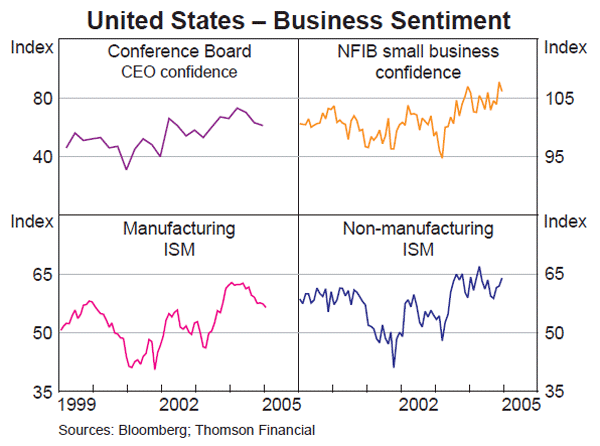
The robust rate of spending by US households and businesses has resulted in a sharp increase in imports into the US, with the volume of imports increasing by 9.2 per cent over the year to the December quarter. Export volumes increased by 4.1 per cent over the same period, reflecting modest overall growth among key trading partners. As a result of these trends, the external trade deficit has widened to 5.7 per cent of GDP, and imports are now around 60 per cent larger than the level of exports.
Core inflation has been gradually trending higher, albeit from very low levels. Excluding the volatile food and energy components, the CPI rose by 2.2 per cent over the year to December, up from 1.1 per cent in late 2003 (Graph 4). However, inflation measures derived from personal consumption expenditures (PCE) show a more muted increase. Against this backdrop, the Federal Reserve has continued the process of normalising interest rates, lifting the federal funds rate by 25 basis points at each of its last six meetings, to 2.5 per cent in February.
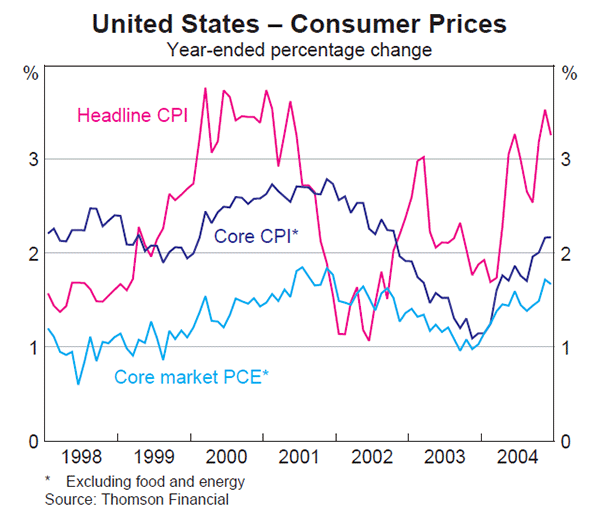
Asia-Pacific
Japan
The Japanese economy is continuing to recover, but the pace has shifted down since late 2003 and early 2004. Real GDP grew by 0.1 per cent in the September quarter, having contracted by 0.1 per cent in the June quarter, though in year-ended terms growth was a healthier 2.5 per cent (Graph 5). The restatement of Japan's national accounts on a chain-weighted basis confirmed that the accounts had for several years been overstating growth in real GDP. Nominal GDP, which was unaffected by the changes, was steady in the September quarter and increased by 1.0 per cent over the year. While the pattern of the recent GDP data has been uneven, the message from business surveys and the labour market has been more positive.

The slowing in activity has been largely concentrated in the business and external sectors, consistent with the moderation of the global ITC cycle and the easing in demand seen in other countries. Industrial production growth fell to 1.4 per cent over the year to December. According to a range of surveys, business sentiment eased in the December quarter but remains healthy (Graph 6). Machinery orders rose sharply in November, having drifted lower in the previous four months. Merchandise exports also rebounded in the December quarter. The overall financial position of firms remains sound – corporate debt has fallen as a share of GDP to levels not seen since the 1980s. Business surveys indicate that the excess labour and capacity problems of the past decade have been largely worked off. The banking sector seems likely to meet the government's targets for reducing non-performing loans to around 4 per cent of total lending by the end of March, and the decline in bank lending appears to be moderating. In all, the corporate sector seems well placed to provide the impetus for ongoing growth in the Japanese economy.
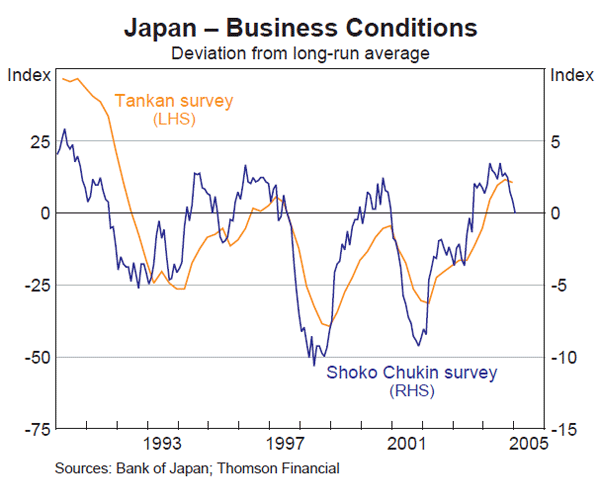
Conditions are still generally favourable in the Japanese labour market. Despite some monthly volatility, the unemployment rate remains on a downward trend and has fallen by ½ percentage point over the past year to reach 4.4 per cent in December. This partly reflects a shrinking labour force owing to the ageing of the population, but it is consistent with the payrolls survey, which reports that employment has grown by around ½ per cent over the year. Forward-looking indicators, including firms' hiring intentions and consumers' perceived employment prospects, are also positive.
Keying off a healthier labour market and buoyant consumer sentiment, household spending rose by 2.1 per cent over the year to the September quarter. Consumer spending has held up despite ongoing falls in real household income, as households appear increasingly willing to save at a lower rate. The weakness in household income has been largely a result of firms' efforts to restrain average wages growth by substituting part-time for full-time workers. The effect of falling average wages has generally outweighed that of rising employment, contributing to the softness in labour income. The government has announced that in the 2005 fiscal year it will repeal the tax cuts introduced in 1999, which may exert a dampening influence on household spending.
With activity measures still fairly upbeat, deflationary pressures have eased further. Domestic corporate goods prices rose by 1.9 per cent over the year to December – the fastest pace of growth since the early 1990s – largely reflecting the run-up in global commodity prices. Sharply rising fresh food prices in the wake of recent typhoons pushed year-ended consumer price inflation to 0.2 per cent in December. Excluding fresh food, consumer prices fell by 0.2 per cent over 2004, with a boost from higher energy prices. The new chain-weighted GDP deflator also indicates some lessening in the rate of deflation, being 1.4 per cent lower over the year to the September quarter compared with 1.7 per cent lower over the year to the June quarter. Nationwide land prices are yet to show much sign of turning around, though, declining by 7.9 per cent over the year to the September quarter.
China
The Chinese economy continues to perform strongly, though the pace of growth eased somewhat during 2004. Over the past couple of years China has directly accounted for a quarter of overall growth in the world economy and has made a similar contribution to growth in global trade. China's real GDP rose by 9.5 per cent over the year to the December quarter (Graph 7). Growth in industrial production has slowed gradually but remains strong; production expanded by 14.4 per cent over the year to December, down from a peak of 19.4 per cent in March. Merchandise trade continues to grow very rapidly, reflecting the competitiveness of China's exports in world markets and strong domestic demand. Exports increased by around 33 per cent over the year to December, while imports were 25 per cent higher. Growth in retail sales has risen in recent months.
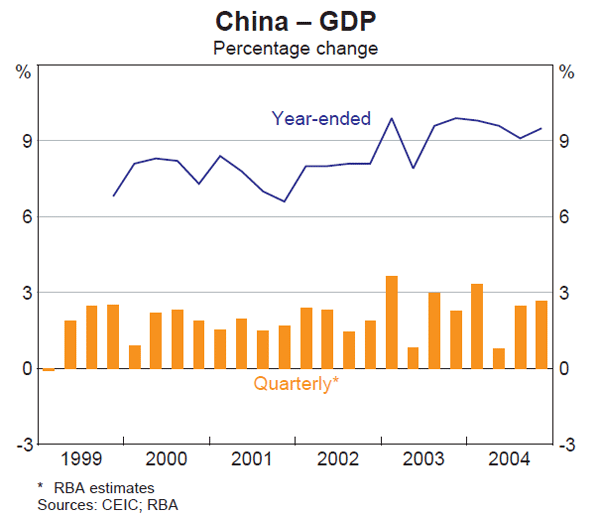
Since late 2003, the Chinese authorities have implemented a series of measures aimed at generating a more sustainable mix of growth. The measures have been directed at curbing over-investment in certain sectors of the economy (such as cement, steel, and property), and reining in credit and money supply growth. Year-ended growth in credit and the money supply seems to have stabilised recently, at around 14½ per cent over the year to December, following a pronounced deceleration earlier in the year. The People's Bank of China is aiming for 15 per cent growth in the money supply in 2005. In the case of investment, fixed-asset investment increased by 21 per cent over the year to December. While this indicates a slowing in the pace of growth during 2004, as a share of GDP investment is estimated to have risen to around 45 per cent in 2004, which is the highest level on record and about as high an investment share as has been seen anywhere in the world.
Consumer price inflation eased to 2.4 per cent over the year to December, down from the peak of 5.3 per cent in the middle of the year (Graph 8). The easing in price pressure largely reflects an unwinding of the earlier run-up in food prices; the ex-food measure has drifted higher to be up by around 1½ per cent over the year. Upstream price pressures continue to be evident, with producer prices rising by 7.1 per cent over the year to December.
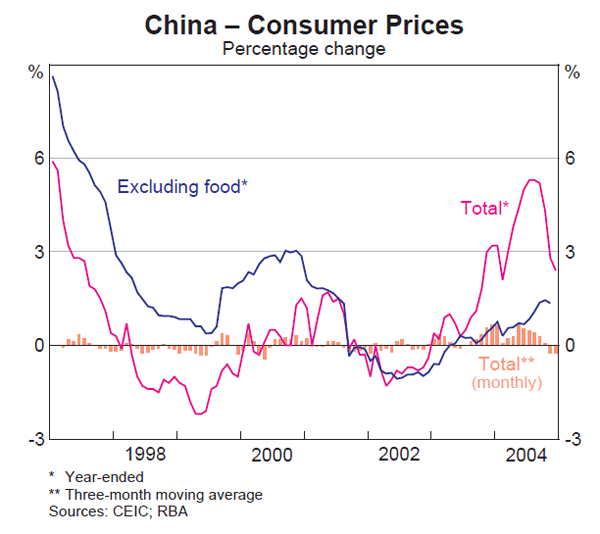
Other Asia-Pacific
Elsewhere in east Asia, economic growth has also slowed a little recently, but remains solid (Graph 9). In aggregate, GDP increased by 5.6 per cent over the year to the September quarter, with particularly strong growth recorded in Hong Kong and the Philippines. Exports continued to advance at a vigorous rate, though not quite as quickly as earlier in the year. With the exception of Korea, conditions appear favourable for a continued pick-up in domestic activity.
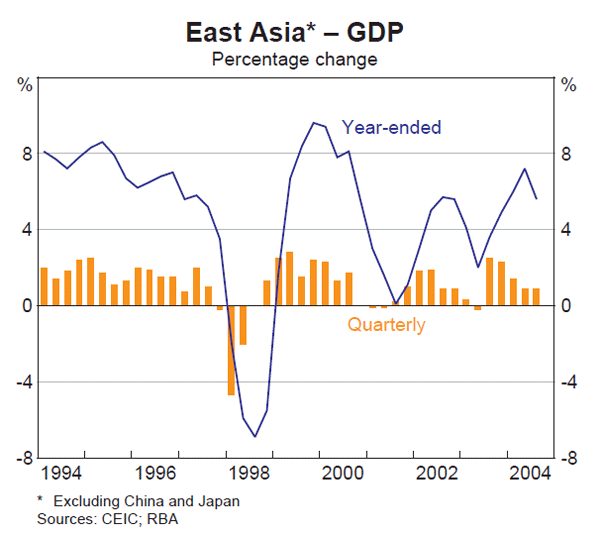
While it is still too early to make a full assessment of the economic effect of the south Asian tsunami, at this stage it seems that the overall effect on GDP will be modest in relation to the size of the region's economy. Some countries will be more affected than others: the Maldives and Sri Lanka are expected to be the hardest hit, and the Thai and Indonesian economies are also likely to be affected.
Growth in the region's exports has slowed from the very brisk pace earlier in 2004, but remains strong. Merchandise exports were 14 per cent higher over the year to December, down from 29 per cent in May. This is consistent with the easing in global demand for ITC goods, which account for around 35 per cent of the region's exports. Growth in world semiconductor sales, a widely used indicator of the state of the global ITC cycle, fell from 40 per cent in year-ended terms in June to 15 per cent in December (Graph 10). Nevertheless, ongoing strength in the Chinese economy continues to support export growth.
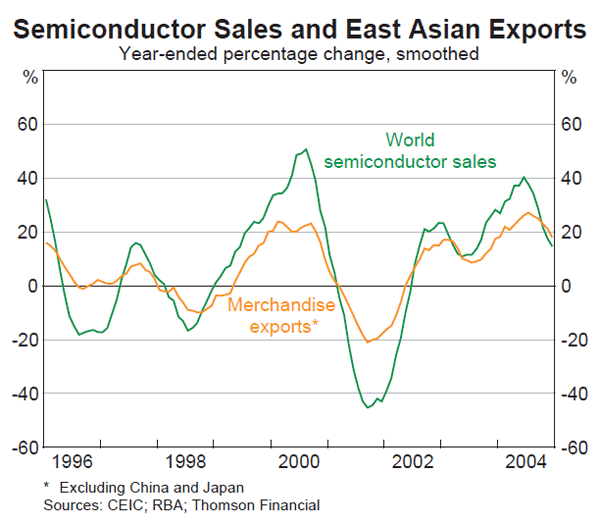
Recent indicators suggest a positive outlook for domestic demand. Retail sales picked up in the December quarter in most countries, and capacity utilisation rates are at levels not seen since before the Asian financial crisis. Labour markets in the region continue to improve, though some slack remains. Furthermore, growth in property and equity prices should spur household and business spending, along with continuing accommodative policy settings. Korea remains the exception, adversely affected by weak consumer spending, which has been weighed down by excessive household debt. There has been some progress in strengthening household balance sheets in Korea, but debt-stress indicators are still high and this process seems likely to have further to run. The recent increase in unemployment, low consumer confidence and falling house prices also suggest a recovery in consumption is some way off. In order to support domestic demand, the Bank of Korea cut its policy rate by a further 25 basis points in November, to 3.25 per cent. The government is also planning a sizeable fiscal package in 2005.
Higher food and oil prices led to a marked increase in consumer price inflation throughout the region in mid 2004, particularly in Thailand, Singapore, Korea and the Philippines. More recently, inflation has moderated in most economies in line with easing food and oil prices. Underlying measures of inflation remain relatively contained, though they appear to be on a gentle uptrend, consistent with upstream inflation measures. Together with buoyant activity, this has seen most central banks in the region continue to tighten policy.
In India, aggregate growth has slowed considerably, reflecting weak agricultural production. Real GDP increased by 6½ per cent over the year to the September quarter, down from 10½ per cent over the course of 2003. Industrial production continues to advance strongly, rising by around 8 per cent over the year to November, and merchandise exports climbed sharply in the December quarter. Inflation has eased a little in recent months following a noticeable rise in the middle of the year. The wholesale price index – the preferred inflation measure in India – was 6.5 per cent higher over the year to December, having risen by 8.7 per cent over the year to August.
The New Zealand economy is growing strongly. GDP expanded by 0.6 per cent in the September quarter, to be 4.4 per cent higher over the year. Domestic demand remains the driver of growth, rising by 8.3 per cent over the year. In contrast, net exports have been a significant drag on growth, largely because of weak merchandise exports. Consumer demand is being underpinned by strong labour market conditions; the unemployment rate is currently 3.8 per cent, which is its lowest level since the early 1980s. The relative strength of the domestic economy is also evident in the inflation data. Non-tradables inflation was 4.3 per cent over the year to the December quarter, while tradables inflation was only 0.7 per cent over the period.
Europe
Economic data from the euro area have been disappointing in recent months. Euro-wide GDP expanded by 0.3 per cent in the September quarter, and year-ended growth eased to 1.8 per cent as a result of a fall in export growth (Table 2). The earlier variation in the pace and composition of growth among the member countries narrowed in the September quarter, as GDP growth slowed sharply in France and remained subdued in Germany, Italy and the Netherlands. Spain was the only major economy to maintain respectable growth. There has also been a slowing in industrial production; year-ended growth fell from around 3 per cent in the middle of the year to 0.7 per cent in November, reflecting falls in German and Italian production. This is consistent with developments in the manufacturing PMI, which declined over the second half of 2004 and is currently only modestly above neutral levels.
| June quarter 2004 |
September quarter 2004 |
Year to September quarter 2004 |
|
|---|---|---|---|
| Euro area | 0.5 | 0.3 | 1.8 |
| – Germany | 0.4 | 0.1 | 1.3 |
| – France | 0.6 | 0.0 | 1.9 |
| – Italy | 0.4 | 0.4 | 1.3 |
| – Netherlands | −0.1 | 0.3 | 1.5 |
| – Spain | 0.5 | 0.6 | 2.6 |
| United Kingdom | 0.9 | 0.5 | 3.1 |
|
Source: Thomson Financial |
|||
Domestic demand will need to pick up if the recovery in the euro area is to gather pace. To date, there has been only a gradual upturn in investment despite strong profit growth and positive business sentiment (Graph 11). Euro-wide retail sales fell slightly in the three months to November. In Germany, household consumption has not expanded since the first quarter of 2003. Circumstances are slightly more encouraging in France, where households are benefiting from wealth gains associated with double-digit house price growth. The recovery of household spending in France stalled in the September quarter, with consumption falling by 0.2 per cent, but the sharp increases in retail spending observed in the December quarter suggest this was probably a temporary setback.
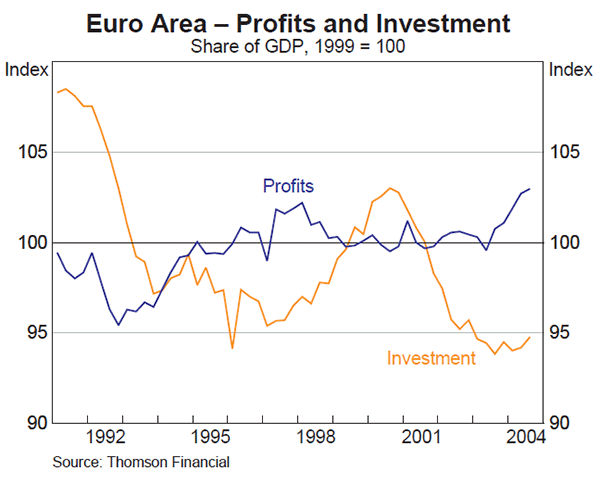
Euro-wide measures of business confidence are holding above long-run average levels and could help support a continuing recovery. Ongoing optimism in France has offset some weakening of business confidence in Germany and Italy. In contrast, household sentiment remains subdued. Although it has drifted up in recent months, consumer sentiment is still below long-run average levels, held down by concerns about high unemployment and the effect of structural reforms that are under way (Graph 12). Euro-wide unemployment was 8.9 per cent in December.

Despite the soft economic growth, inflation has lingered above the ECB's 2 per cent reference level. Euro area consumer prices rose by 2.4 per cent over the year to December, with higher energy prices making a significant contribution, along with hikes in prices of administered items, such as health care and tobacco. In underlying terms, inflation has been steady at 1.9 per cent. The ECB has emphasised the risk of increased energy costs feeding through into wages and general inflation, but given lacklustre output growth, it has kept its policy rate at 2 per cent since June 2003.
Growth in the United Kingdom has begun to moderate as the housing sector has responded to the tightening of monetary policy over the past year or so. After slowing in the September quarter, GDP rose by a solid 0.7 per cent in the December quarter. Year-ended growth fell to 2.8 per cent, from a peak of 3.5 per cent in the June quarter. Although export growth remains healthy, net exports subtracted 0.7 percentage points from GDP growth over the year to the September quarter, reflecting growth in imports from strong domestic demand.
Official data suggest that industrial production contracted slightly over the year to November, but other measures show a brighter picture. Surveys of consumer and business confidence are generally above long-run averages and unemployment is near its lowest level in almost 30 years. However, activity in the housing market has slowed noticeably from its heady pace earlier in the year. Surveys and official data indicate flat or falling house prices across the UK; according to the Nationwide and Halifax surveys, house prices increased at an annualised rate of 1.8 per cent over the past three months, compared with annualised growth in excess of 20 per cent in the first half of 2004. The value of housing loan approvals was down by 25 per cent from the peak in late 2003.
Despite a tight labour market and strong growth in input prices, consumer price inflation was 1.6 per cent over the year to December, below the Bank of England's 2 per cent target rate. The Monetary Policy Committee has held the repo rate at 4.75 per cent since August.
Oil price developments
After peaking at around US$56 per barrel in late October, the West Texas Intermediate crude oil price has fallen back in recent months to around US$47 per barrel in early February (Graph 13). The fall in prices appears to reflect the easing of a number of the supply concerns and speculative pressures that had pushed prices to levels that were generally perceived as above those dictated by long-run fundamentals. However, the easing in price pressures, which saw crude oil prices fall to around US$41 per barrel in early December, has been interrupted by the resolution of OPEC on 10 December to curtail above-quota production of oil, owing to concerns that prices would continue to fall. The market has also been affected by ongoing supply disruptions in Iraq, which have arisen from technical difficulties and sabotage ahead of the Iraqi elections.
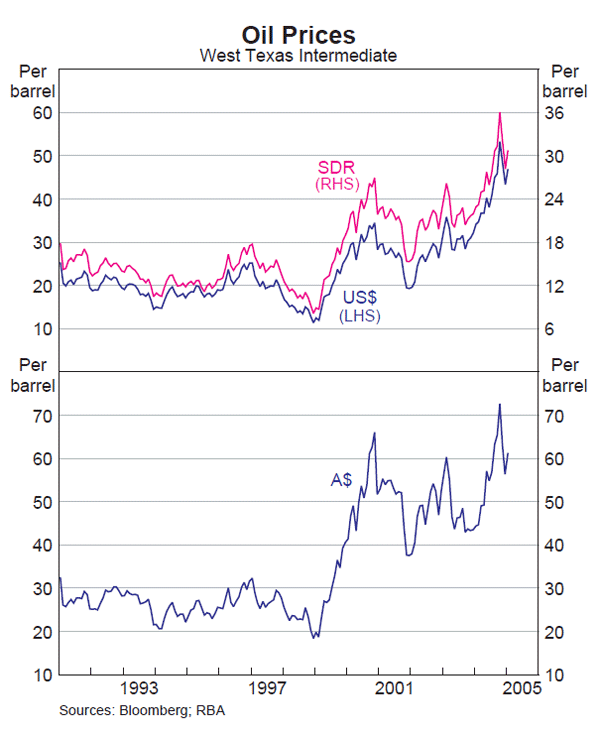
International and Foreign Exchange Markets
Exchange rates
The broad-based decline in the US dollar that had resumed in October continued apace through to the end of 2004 (Graph 14, Table 3). In the December quarter, the US dollar declined by 8 per cent against the euro, 7 per cent against the yen and 5 per cent on a broad trade-weighted basis. The decline primarily reflected the market's focus on the US current account deficit. During this period, the dollar reached a low of 102 against the yen, and 1.365 against the euro – the lowest level since the latter's introduction in 1999. Using the European Currency Unit (the precursor to the euro) as a proxy, the bilateral exchange rate against the euro area was the lowest since 1992, when it reached the equivalent of 1.45.
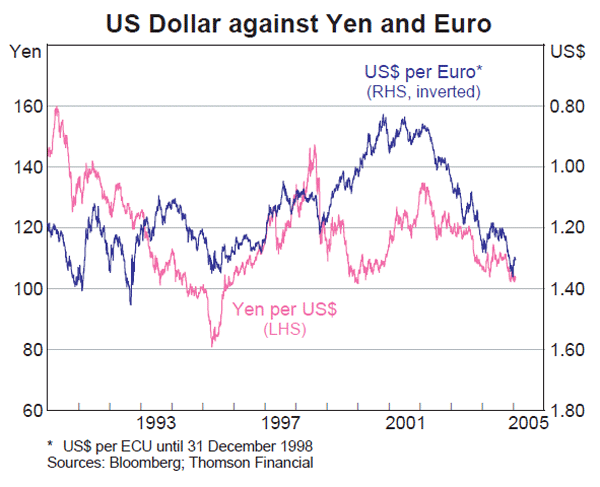
| Since January 2004 |
2005 year to date |
December quarter 2004 |
|
|---|---|---|---|
| South Africa | 8.8 | −6.6 | 12.0 |
| South Korea | 13.0 | 0.7 | 10.2 |
| Switzerland | 2.9 | −5.4 | 10.1 |
| Sweden | 2.4 | −5.2 | 9.8 |
| Euro area | 2.1 | −4.6 | 9.5 |
| Australia | 0.4 | −0.1 | 8.3 |
| Japan | 2.6 | −0.9 | 7.3 |
| Brazil | 8.1 | 2.0 | 7.2 |
| New Zealand | 4.8 | −0.7 | 6.9 |
| Taiwan | 6.2 | 0.2 | 6.6 |
| United Kingdom | 2.8 | −2.2 | 6.5 |
| Thailand | 1.3 | 1.4 | 5.8 |
| Canada | 3.2 | −2.8 | 5.2 |
| India | 4.5 | 0.5 | 5.1 |
| Singapore | 3.5 | −0.1 | 3.3 |
| Mexico | −3.1 | −0.1 | 2.1 |
| Hong Kong | −0.5 | −0.3 | 0.3 |
| Philippines | 0.5 | 2.3 | 0.0 |
| China | 0.0 | 0.0 | 0.0 |
| Malaysia | 0.0 | 0.0 | 0.0 |
| Indonesia | −10.1 | 1.3 | −1.5 |
| US broad TWI | −1.6 | 1.6 | −5.1 |
|
Source: RBA |
|||
A notable feature of the most recent movement in the US dollar is that it has also depreciated significantly against a number of east Asian currencies such as the Korean won. The Korean won rose 10 per cent against the US dollar in the December quarter despite the reduction in Korean policy rates, weaker economic data and exchange rate intervention. This is in contrast to the situation in late 2003/early 2004 when movements in many east Asian currencies were limited by substantial central bank intervention in the market.
Thus far in 2005, the dollar has risen back to around 1.30 against the euro, in part reflecting the fact that the US federal funds rate has now risen above the monetary policy rate in the euro area, as well as comments from European officials expressing concerns about the extent of the appreciation of the euro. The dollar has also appreciated against a number of the other major currencies, including the pound and Canadian dollar. In contrast, the dollar has tended to remain close to its lows against the yen and has even continued to depreciate against other Asian currencies over the past month.
In recent months, implied volatility in foreign exchange markets has remained at relatively elevated levels for some currencies, reflecting the large movements in currencies that have taken place. This stands in contrast to equity and fixed-interest markets where implied volatilities are close to their historical lows (see Box A).
Expectations of a revaluation of the Chinese currency intensified in the closing months of last year but have since been scaled back somewhat. The 1-year non-deliverable forward (NDF) rate for the renminbi rose by 2½ per cent over November and December as officials stated China's commitment to flexibility in the exchange rate without confirming any timetable for regime change. However, the rate has declined modestly since then, as markets have assessed that a change is not imminent. With the recent scaling back of expectations, the probability attached to a revaluation is slightly lower than at the beginning of 2004.
Australian dollar
Movements in the US dollar have been the major influence on the Australian dollar since the last Statement. The broad-based fall in the US dollar over the December quarter saw the Australian dollar reach US79.46 cents in late November, just below the recent cyclical high of US80.05 seen in February last year. In recent weeks, as the US dollar has stabilised, the Australian dollar has generally traded in a range between US76 and US79 cents. The Australian dollar has appreciated against most other major trading partners that float over the past few months (Graph 15, Table 4).
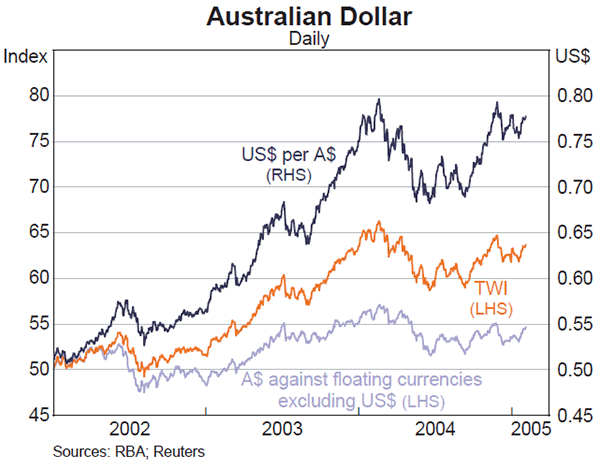
| Since January 2004 |
2005 year to date |
December quarter 2004 |
|
|---|---|---|---|
| Indonesia | 10.6 | −1.4 | 10.6 |
| US | 1.8 | −0.1 | 9.0 |
| Philippines | −0.1 | −2.4 | 9.0 |
| PNG | −4.3 | −0.3 | 6.4 |
| Singapore | −2.1 | 0.0 | 5.4 |
| TWI | −1.2 | 0.8 | 3.7 |
| Canada | −5.3 | 2.7 | 3.3 |
| UK | −1.9 | 2.1 | 1.9 |
| Taiwan | −3.4 | −0.3 | 1.8 |
| NZ | −4.4 | 0.6 | 1.4 |
| Japan | −0.5 | 0.8 | 1.1 |
| Euro area | −3.0 | 4.5 | −1.3 |
| Sweden | −4.0 | 5.1 | −1.7 |
| Switzerland | −3.5 | 5.2 | −2.0 |
| South Korea | −11.0 | −0.8 | −2.1 |
| South Africa | −12.8 | 6.4 | −4.1 |
|
Source: RBA |
|||
As noted in previous Statements, offshore movements in the Australian dollar continue to dominate movements during the onshore trading session (Graph 16). In recent months this has reflected the large moves of the US dollar against all currencies in the US trading session.
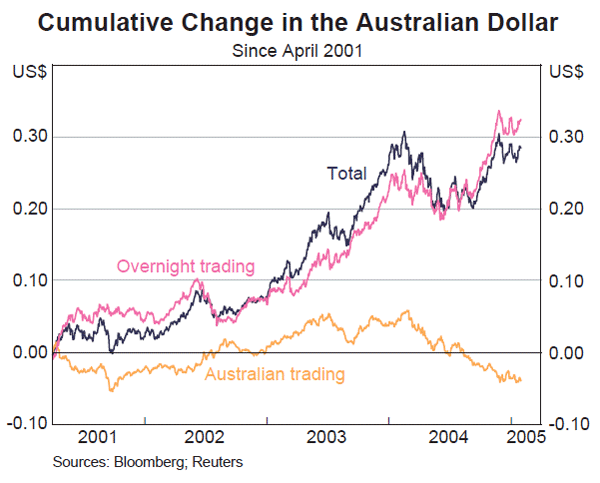
Market sentiment towards the Australian dollar remains positive. As the exchange rate appreciated through to late November, speculative positioning in Australian dollar futures on the Chicago Futures Exchange rose to record levels. While there has been a substantial scaling back in speculative short positions against the US currency in recent months, especially vis-à-vis the euro, there is little sign that long positions in the Australian dollar have been trimmed. Sentiment in the options market, as indicated by 1-month risk reversals (a measure derived from the relative prices of put and call options in the Australian dollar), has also become more bullish since mid 2004. In addition, continuing robust Uridashi issuance appears to have provided ongoing support for the Australian dollar, despite increased maturities of existing A$ Uridashi bonds. Monthly Uridashi issuance averaged $1.6 billion over the second half of 2004, in excess of its average for the previous three years.
As the Australian dollar appreciated against the US dollar in November, the Bank took the opportunity to add to net reserves through its transactions in the foreign exchange market. In November, $730 million were added to net reserves as a result of transactions. As the Australian dollar eased from its highs against the US dollar, the Bank has scaled back its purchases of foreign exchange in the market to a rate only a little above that sufficient to cover the requirements of the Government. Some of the addition to net reserves over the past three months that resulted from transactions and earnings were offset by valuation effects imparted by the appreciation in the exchange rate. As a result, net reserves rose only marginally, from $24.2 billion at the end of October to around $25 billion at the end of January. At the end of January holdings of foreign exchange under swaps were little changed at around $22 billion.
Money markets
The US Federal Reserve raised the federal funds rate by 25 basis points at each of its three meetings since the last Statement. Since the beginning of its current tightening cycle in June 2004, the federal funds rate has been increased from 1.0 per cent to 2.5 per cent in increments of 25 basis points at each Federal Open Market Committee (FOMC) meeting. Reflecting indications that US economic growth remains robust and concerns that inflationary pressures may be building, markets are now expecting the federal funds rate to reach 3¼ per cent by August, which implies 25 basis point increases at three of the next four FOMC meetings (Graph 17). This is significantly higher than expected at the time of the last Statement, when futures markets expected that the federal funds rate would only be around 2½ per cent in the middle of 2005.
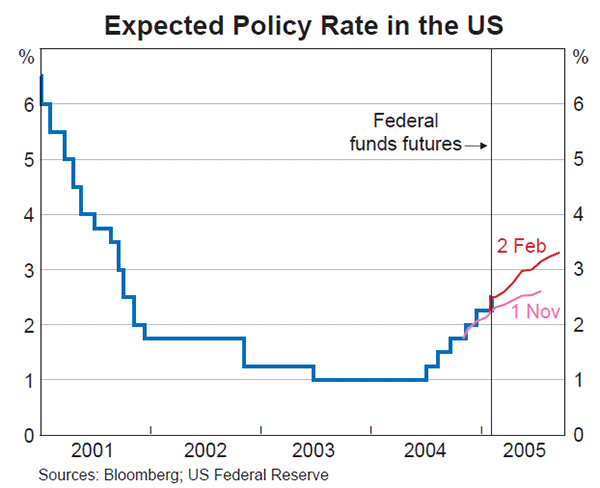
The European Central Bank (ECB) and the Bank of Japan (BoJ) are still not expected to raise interest rates for some time. Indeed, as expectations for economic growth have been scaled back somewhat in both regions over the past three months, markets have pushed back their expectation of the timing of the first tightening by both central banks. Futures markets are not expecting the ECB to raise interest rates from their current level of 2 per cent until at least the end of 2005, while a tightening is not expected in Japan until at least 2006.
Other industrial country central banks have left interest rates unchanged over the past three months (Graph 18). After increasing their policy rates by 125 basis points and 150 basis points respectively in the current cycle, market participants expect that the tightening cycles in both the UK and New Zealand are close to an end, although in both cases, recent inflation data have caused some participants to revise that assessment. The Bank of Canada is expected to tighten further in the months ahead, with rates still relatively low at 2.5 per cent. In each of these countries, the decision to leave interest rates unchanged in part reflected an assessment of the potential impact of the appreciation of their exchange rates against the US dollar over 2004.
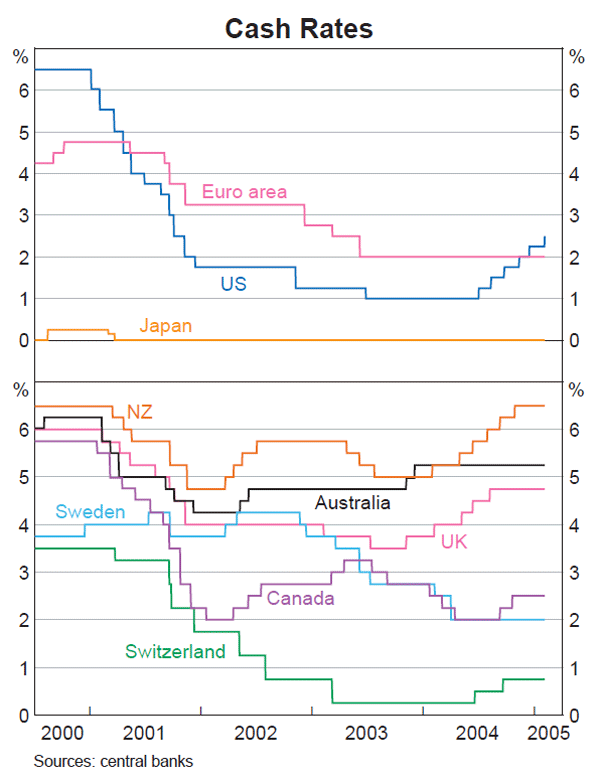
Monetary policy continued to be tightened in a number of emerging market countries, including Brazil, Chile, Mexico, Taiwan and Thailand, reflecting building inflationary concerns. In contrast, the Bank of Korea reduced interest rates by 25 basis points in November, for the second time in six months, reflecting continued weak domestic demand and a rising exchange rate. Policy rates were also lowered by 300 basis points in Turkey as inflation in that country continues to decline from high levels.
Bond yields
Yields on 10-year US government bonds have remained within a relatively narrow range around 4.2 per cent over the past three months. This is well below the high of 4.9 per cent seen in June 2004, despite the 150 basis point increase in the federal funds rate since then and signs that inflationary pressure may be building. In contrast to previous tightening episodes in the US, long-term yields have remained stable and even declined as the short-term rate has been increased (Graph 19). In previous episodes, long yields tended to rise in the early stages of a tightening cycle at least as much as the rise in short rates, reflecting inflation concerns. In part, the current situation is likely to reflect the increased credibility of the Federal Reserve in maintaining low and stable inflation, and may also be attributable to an improvement in communication by the Fed of its intentions. Offshore demand for US fixed-income investments, both from official and private sources, has also had a strong influence.
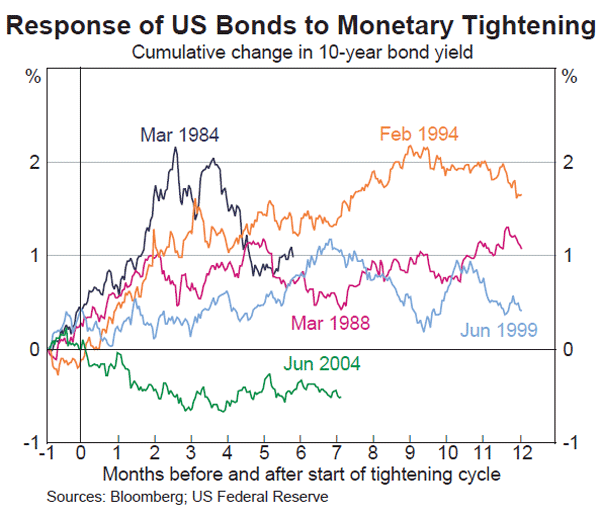
After trading in line with US yields for much of 2004, movements in European and Japanese government bond yields have decoupled from those in the US in recent months, largely reflecting the scaling back in the outlook for economic growth in both economies. German bond yields have declined over the past three months to be only slightly above the multi-decade lows seen in early 2003, while Japanese yields have also edged downward. The spread between US and German 10-year bond yields has widened to 60 basis points, its widest level since late 2000, although the spread was considerably wider than this for much of the second half of the 1990s.
The continuing low level of government bond yields has supported the search for yield that has been evident over the past couple of years, with the spread between yields on US government debt and yields on both corporate and emerging market debt remaining around historical lows over the past three months (Box B).
Equity markets
After relatively lacklustre growth for the first three quarters of 2004 (with the notable exception of the Australian market), global equity markets rose strongly in the December quarter, in part reflecting renewed confidence about the strength of the economic recovery in the US (Graph 20, Table 5). The US S&P 500 increased 9 per cent in the quarter which accounted for all of the rise in the index over 2004, while the NASDAQ recorded a particularly strong increase of 15 per cent in the quarter. Broad-based equity indices in Japan and Europe also rose strongly in the December quarter, with the Euro STOXX up 8 per cent and the TOPIX up 4 per cent.
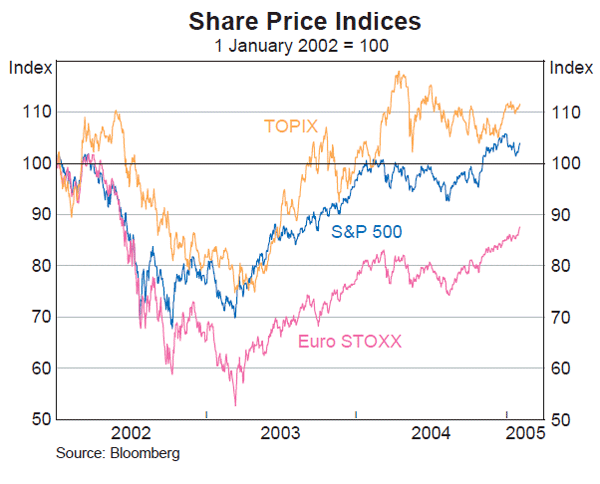
| Since 2000 peak |
Since 2003 trough |
2004 | Dec qtr 2004 |
|
|---|---|---|---|---|
| United States | ||||
| – Dow Jones | −10 | 41 | 3 | 7 |
| – S&P 500 | −22 | 49 | 9 | 9 |
| – NASDAQ | −59 | 63 | 9 | 15 |
| Euro area | ||||
| – STOXX | −41 | 67 | 10 | 8 |
| United Kingdom | ||||
| – FTSE | −29 | 50 | 8 | 5 |
| Japan | ||||
| – TOPIX | −34 | 49 | 10 | 4 |
| Canada | ||||
| – TSE 300 | −18 | 49 | 12 | 7 |
| Australia | ||||
| – ASX 200 | 23 | 54 | 23 | 11 |
|
Source: Bloomberg |
||||
Emerging equity markets have also performed strongly in recent months. Average share prices rose 5 per cent in emerging Asia since the last Statement, with the strongest gains occurring in India, Indonesia and Thailand. Chinese shares fell 8 per cent amid some relatively poor earnings reports and continuing concerns about government actions to slow the economy. In Latin America, average share prices rose 7 per cent.
Box A: Declining Volatility in Global Asset Markets
As derivative markets have become more liquid and the use of instruments such as options more widespread, it has become increasingly possible to use information from these instruments to analyse underlying asset markets. For example, pricing of options on equity, fixed-interest or foreign exchange instruments contains information about the respective derivatives markets' assessment of current conditions and expected future price movements in the underlying markets. In this box we use the implied volatility of options[1] to contrast fixed-interest and equity markets, where implied volatility has declined noticeably, with foreign exchange markets where volatility has not fallen as sharply.
Implied volatilities of the major equity indices have declined substantially since the start of 2003 (Graph A1). The high volatility seen over 2002 reflected heightened uncertainty about the global economic outlook following the US recession, corporate malfeasance, the unwinding of the equity market bubble and the war in Iraq. Volatility moderated as major equity indices began to rebound, corporate profits staged a strong recovery, and the general economic outlook improved. The recent levels of implied volatilities for the three major overseas equity markets are low, but not unprecedented. Implied volatilities in the US and Europe have returned to levels that were typical between 1992 and 1996. Implied volatility in Japan, despite its recent fall, remains well above the lows reached in 1994. In contrast, the implied volatility of Australian equities is at an all-time low.
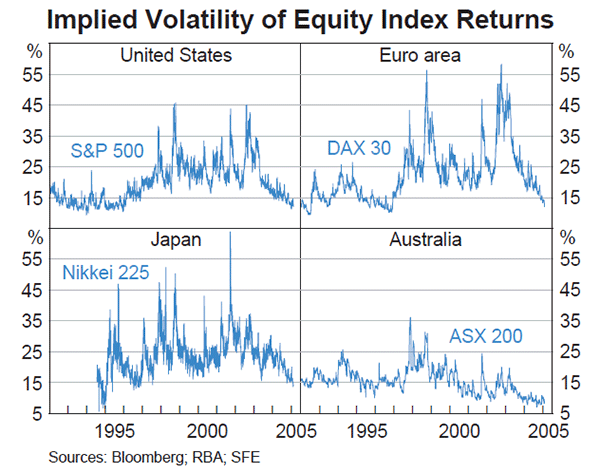
Implied volatilities in fixed-interest markets have also declined significantly, with the volatilities of shorter-term instruments falling by more than those of longer dated ones (Graph A2). Implied volatilities gradually declined around the world in the second half of 2003, as it became clearer that the easing cycle was drawing to a close, with some central banks beginning to tighten monetary policy after a prolonged period of relatively low and stable interest rates. It is possible that a large part of the decline in implied volatilities of interest rates can be attributed to reduced uncertainty about the future path of monetary policy at that turning point.
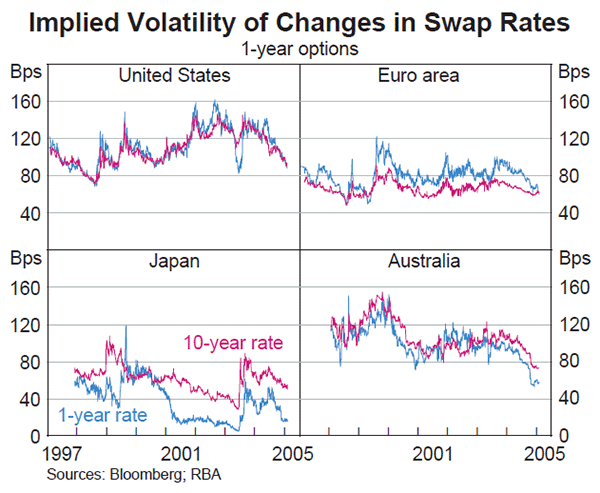
There appears to be little evidence that the compression of volatilities in equity and debt markets is being driven by an increased willingness to supply (write) options. If options writers were underpricing options in order to try to expand their activities, then implied volatility would be persistently below the subsequently realised volatility of the underlying assets over the life of the options. But recently, implied volatilities have generally moved in line with realised volatilities across the major global asset markets.
In January 2002 the US dollar reached a multi-year high on a trade-weighted basis against the major floating currencies. Since then, developments in implied volatilities of currencies against the US dollar have been mixed. Some currencies, such as the Australian and Canadian dollars, have seen increases in both short- and long-term implied volatilities. But for other currencies, such as the euro and the yen, implied volatilities remain broadly unchanged (Graph A3). Overall, implied volatilities of foreign exchange rates have exhibited a less clear trend than those observed in equity and fixed-interest markets.
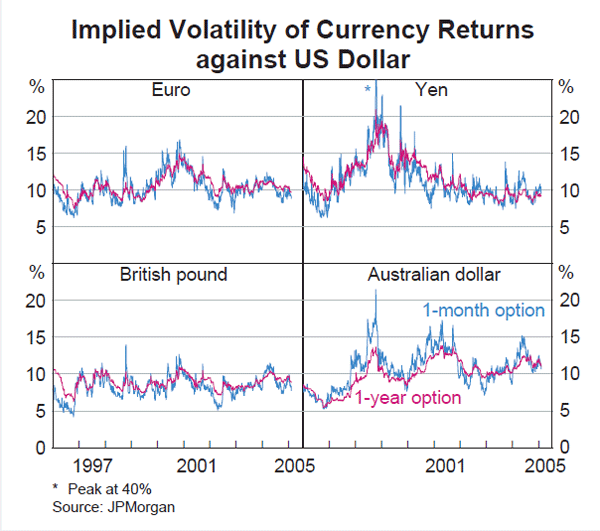
In general, recent developments in option markets indicate an expectation of continued low volatility in equity and bond markets, but continuing uncertainty in foreign exchange markets. Despite these developments, it is possible that the recent low level of realised volatility may have led markets to become a little complacent and hence the low implied volatility may not reflect future risks in these markets.
Box B: The Search for Yield
Over the past couple of years, central banks in most major economies have maintained unusually low official interest rates, which in turn have depressed interest rates on low-risk assets such as government debt. This low interest rate environment and the growing pool of institutional funds have encouraged investors to search for investment options that offer a higher yield. This is evident in a number of developments, including: increased demand for higher-risk assets; the increase in ‘carry trades’ – a form of gearing where funds are borrowed short-term at low interest rates and invested in higher-yielding assets, often in other countries; growth in alternative investment vehicles such as hedge funds; and growth in alternative investment strategies such as selling embedded options (see Box A).
With interest rates on low-risk investments falling to low levels in many countries, investors have sought to maintain yields by moving into higher-risk assets such as corporate debt and emerging market debt. As they have done so, credit spreads on these assets have declined, which means that investors are receiving less compensation for the risk they are taking on. Spreads on US Corporate Junk (B-rated) bonds have fallen by around 600 basis points over the past couple of years while spreads on C-rated bonds have fallen by around 2500 basis points. Spreads on emerging market debt have narrowed by around 500 basis points. All these spreads are currently at very low levels by historical standards (Graph B1).
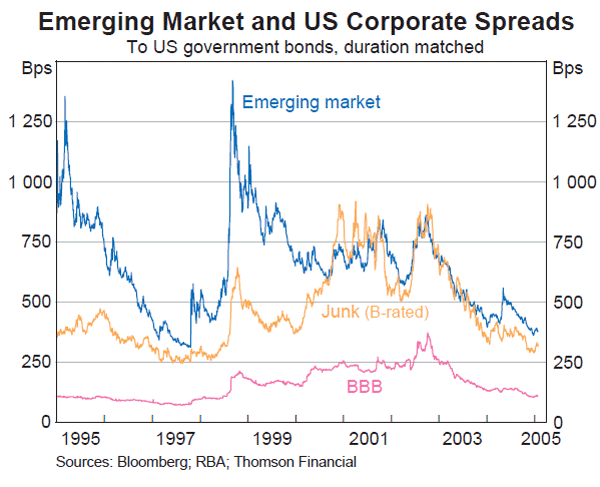
A factor which has encouraged the compression of credit spreads has been the strength of the global economy, as it has led investors to become less risk averse in the face of strong corporate profit growth, sound corporate balance sheets and good economic performance by emerging market economies. While these developments have been taken as signs that the riskiness of corporate and emerging market debt has declined, it remains to be seen whether current spreads are sustainable or whether they are underpricing risk. It is interesting to note, however, that investors do seem to be differentiating between the various types of high-yield investments. For example, the spread on debt of the Philippines has remained at relatively high levels compared to other countries in the region (Graph B2). Likewise the spread on Argentinean debt has remained at relatively high levels compared to other Latin American countries.
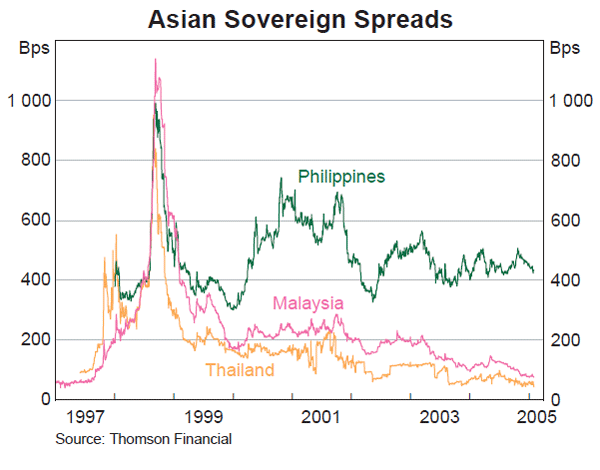
Some investors are also seeking to improve returns by gearing part of their investments through ‘carry trades’. These involve the investor borrowing at the short end of the yield curve, particularly in those countries where rates have been very low, such as the United States, Japan and Switzerland, and investing either further out along the yield curve or in countries where interest rates have been relatively high, such as Australia and the United Kingdom. In doing so, investors are taking on a range of risks such as exposure to changes in the shape of the yield curve, credit spreads or exchange rates. The increased use of carry trades to fund cross-border investments has contributed to the large increase in global foreign exchange turnover over recent years, particularly in currencies like the Australian dollar.[1]
The low interest rate environment may also have encouraged a shift in investments towards hedge funds as, in the past, hedge funds have achieved higher average returns than traditionally managed investments, albeit in exchange for greater risk. Hedge fund assets under management have almost doubled over the past five years and are now estimated to be almost US$1,000 billion (Graph B3). There are signs, however, that the recent large inflows into hedge funds have changed the risk/return characteristics of the industry. Hedge funds appear to be having trouble maintaining their rate of return as their typical investment plays have become ‘crowded’. This in turn has caused some hedge funds to seek a wider range of investment opportunities and to take on more risk.
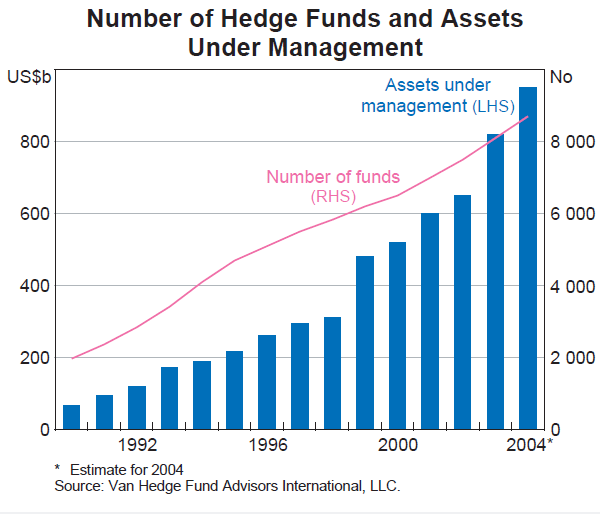
With policy rates increasing in a number of countries, the investment positions put in place over the past couple of years in response to low interest rates are likely to be unwound, particularly as the scope for low-cost funding of these investment strategies will diminish. If circumstances allow the unwinding of these positions to occur in an orderly fashion – e.g. if global inflationary pressures remain subdued and rises in official interest rates take place at a measured pace – the unwinding process is unlikely to put large stresses on financial markets. On the other hand, were an economic shock to cause a faster-than-anticipated rise in global policy rates, these positions could be reversed very sharply, causing dislocation in financial markets.
Domestic Economic Conditions
Growth in the Australian economy as reported in the national accounts slowed during 2004 from the rapid pace in the second half of 2003, as a result of a moderation in the pace of domestic demand growth and a continued drag on growth from subdued exports. GDP was estimated to have grown by 0.3 per cent in the September quarter, with growth over the year slowing to 3 per cent (Graph 21). Growth continued to be driven by domestic demand, with strong growth in consumption and public demand, moderate growth in business investment, but subtractions from dwelling investment and inventories. The most noteworthy impact on growth in the quarter, however, was the ¾ percentage point subtraction resulting from the decline in the net trade balance, as exports fell and imports rose slightly.
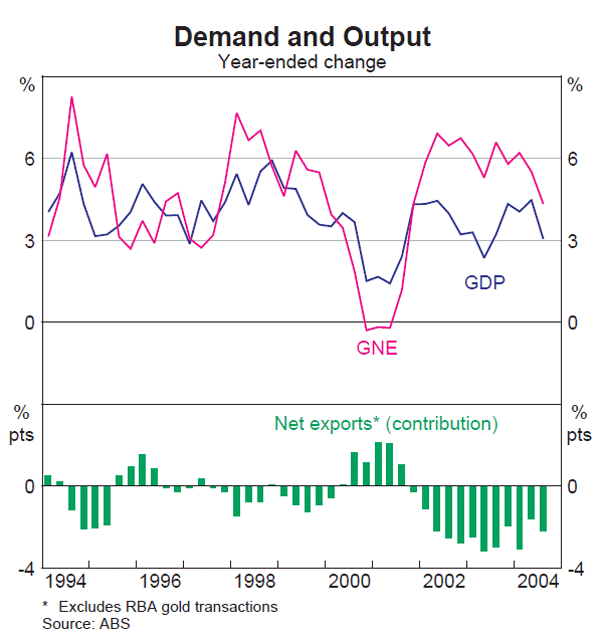
However, a range of other indicators suggested firmer conditions throughout 2004. Business confidence is at high levels and business profitability has been strong. Consumer confidence has been close to record levels, and the labour market continued to strengthen, with the unemployment rate falling in December to its lowest level since 1976. This contrast between the relatively weak picture in the quarterly national accounts and the strong conditions suggested by most other indicators is somewhat unusual.
Household sector
Household consumption remained strong in 2004, increasing by 5.4 per cent over the year to the September quarter. Disposable income grew strongly, outpacing growth in consumption over this period, such that the saving ratio rose. Solid employment growth and firm gains in wages and property income contributed to the growth in household income over the year. Disposable income was also boosted by the measures in the May 2004 Budget, particularly the lump-sum payments associated with the Family Tax Benefit and the income tax cuts from 1 July.
It appears that consumers have saved a larger-than-expected proportion of the proceeds of the fiscal stimulus. In the September quarter, household consumption rose by 1.1 per cent, a slight increase from the pace in the June quarter, but less than might have been expected given the boost to incomes from the budget measures. In addition, retail sales were weaker than expected in October and November (Graph 22). This weakness in spending may partly be explained by rises in petrol prices, which directly subtracted from the amount available for discretionary spending. Alternatively, it may be a reaction by some consumers to the slowing in household wealth resulting from the weakness in house prices. However, it is also possible that the recorded weakness in the retail trade survey reflects sampling variation, given that it was driven mainly by sales of smaller retailers, of which only a sample are surveyed. In contrast, the growth in sales of the fully enumerated larger retailers remained fairly firm.
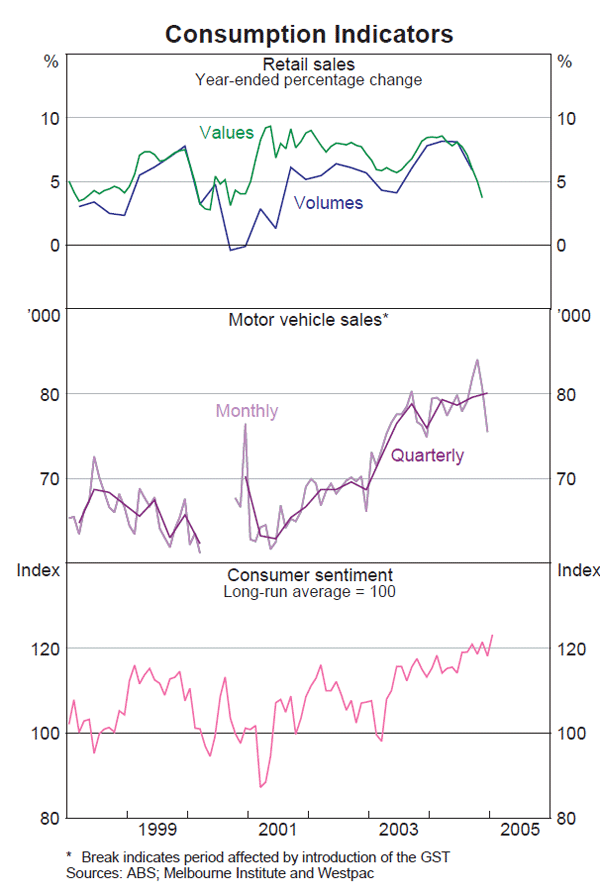
It is important to note that the retail trade survey covers only around 40 per cent of consumer spending and that other recent indicators of consumption have been more positive. Even though the tariff cut on passenger vehicles in January 2005 appears to have encouraged some vehicle buyers to delay their purchases, motor vehicle sales increased a little in the December quarter, resulting in a record level of sales in 2004. Consumer sentiment also remains high, with the Westpac-Melbourne Institute index rising in January to the second-highest level in the 30-year history of the survey. An expected continuation of positive labour market conditions and strong growth in household income, coupled with falling petrol prices and further scheduled tax cuts in July, also point to the pace of consumption growth remaining firm.
Growth in household assets moderated over the three quarters to the September quarter 2004 after growing rapidly over the preceding five years (Table 6). The slowing reflected the recent softness in dwelling prices, which was only partly offset by strong gains in financial assets.
| Level | Share of total Per cent |
Annual growth Per cent | ||
|---|---|---|---|---|
| $ billion | Three quarters to Sep 2004 |
Average Dec 1998– Dec 2003 |
||
| Dwellings | 2,623 | 61.2 | 4.1 | 14.7 |
| Consumer durables | 148 | 3.5 | 3.4 | 4.5 |
| Financial assets(a) | 1,515 | 35.4 | 10.8 | 7.3 |
| – Superannuation and life offices(b) | 791 | 18.5 | 13.3 | 8.0 |
| – Shares and other equity | 273 | 6.4 | 12.0 | 5.9 |
| – Currency and deposits | 365 | 8.5 | 8.7 | 7.7 |
| – Other | 86 | 2.0 | −4.2 | 4.2 |
| Total | 4,286 | 100.0 | 6.4 | 11.4 |
|
(a) Includes unincorporated enterprises Sources: ABS; RBA |
||||
At the same time, growth in credit provided to households remained strong, despite easing from the rapid pace seen in 2003. The ongoing accumulation of household debt has led to a further increase in the debt-servicing ratio; interest payments as a proportion of disposable income rose to 9.3 per cent in the September quarter (Graph 23), and are expected to rise further. While this is an historically high level, at this stage the servicing burden does not appear to be constraining households, with indicators of financial stress – such as loan arrears – remaining low. The recent rise in the debt-servicing ratio is largely a result of households increasing their debt levels, rather than an unexpected sharp rise in interest rates, as occurred in the late 1980s.
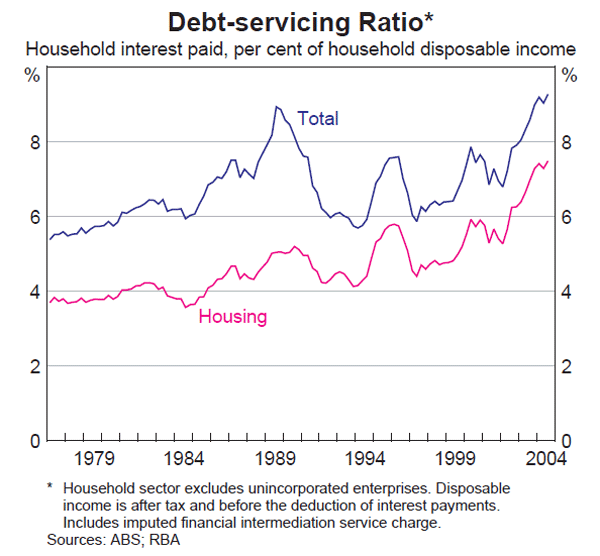
Housing
Construction
The September quarter national accounts showed a small fall in dwelling investment in the quarter, suggesting that the downturn foreshadowed by leading indicators of housing construction is now under way. Building approvals fell by more than 15 per cent over the year to the December quarter, with similar falls recorded in approvals for both houses and medium-density housing (Graph 24). The value of approvals for alterations and additions fell by 5½ per cent over the same period. Other forward indicators, including display home traffic and land sales, also remain subdued; despite rising in November, the Housing Industry Association series on commitments to build remains 21 per cent below its peak in 2003. Sales of inner-city apartments are showing more pronounced weakness because of low investor interest.
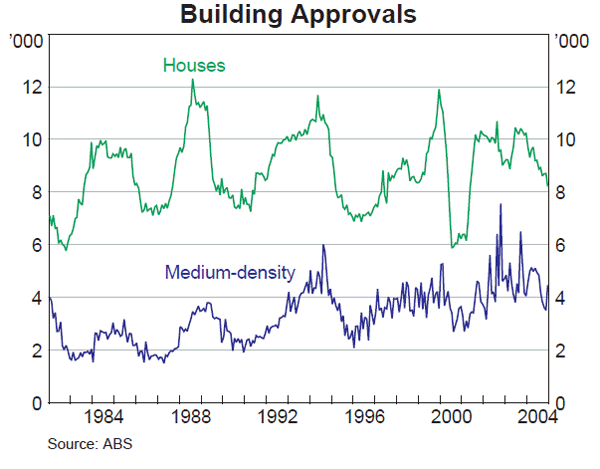
The downturn in dwelling investment that appears to be in train is likely to be mild by historical standards. While the fall in medium-density building approvals from their peak is within the range of previous experience, the fall in approvals for houses, which make up the bulk of dwelling investment, has not been as rapid or as large to date as those observed in previous cycles. Furthermore, underlying demand is at a relatively high level and employment conditions remain favourable. Work yet to be done also remains at a high level and the continued growth in the average value of new dwellings is likely to temper further the expected fall in new dwelling investment.
Financing and prices
Demand for housing finance now appears to have stopped falling after the declines earlier in 2004, and there are some tentative signs that it is starting to pick up. After being broadly flat for several months at a little above $12 billion per month, housing loan approvals rose by about 5 per cent in November. Over the six months to December, housing credit grew at an annualised rate of 12½ per cent, down from 22½ per cent over the second half of 2003. Within the total, investor loan approvals and credit have slowed much more than the owner-occupier components. After peaking in late 2003 at close to double the rate of growth in owner-occupier credit, the growth rate of investor credit is now similar to that for owner-occupier housing credit.
Following weak conditions in housing markets during the first three quarters of 2004, there is some evidence that median house prices rose moderately in the December quarter, though this may have largely reflected seasonal composition effects, which have tended to boost median price measures in the December quarter in previous years. The available data suggest nationwide average prices remained lower than a year earlier, driven by weakness in Sydney and Melbourne (Graph 25 and Table 7). As is usual, there is a wide range of estimates of average price changes, and most measures are subject to revision. The strongest estimates for the change in the December quarter are from the Commonwealth Bank of Australia (CBA), based on CBA housing loans to owner-occupiers, but this measure has shown the greatest swings over the past few years. The weakest estimates are from Australian Property Monitors (APM), based on land titles offices' records, but these are likely to be revised upwards as more sales are reported to state governments. Nationwide apartment prices also appear to have risen modestly in the December quarter.
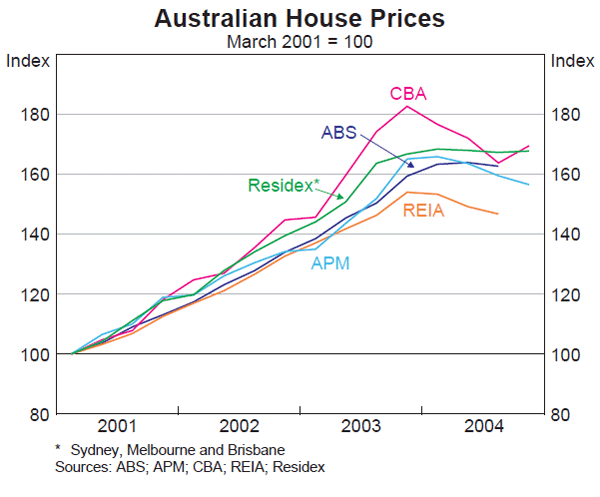
| APM | CBA | REIs | Residex | ||||||||
|---|---|---|---|---|---|---|---|---|---|---|---|
| Dec qtr 2004 |
Year to Dec qtr 2004 | Dec qtr 2004 |
Year to Dec qtr 2004 | Dec qtr 2004 |
Year to Dec qtr 2004 | Dec qtr 2004 |
Year to Dec qtr 2004 | ||||
| Sydney | −5.4 | −9.9 | −0.8 | −15.7 | na | na | −0.3 | −2.5 | |||
| Melbourne | −1.4 | −11.3 | 4.2 | −7.5 | 5.2 | −1.3 | 0.1 | 1.9 | |||
| Brisbane | 0.0 | 4.2 | 3.8 | −0.8 | na | na | 1.4 | 3.5 | |||
| Adelaide | 2.7 | 10.8 | 8.9 | 7.0 | 3.4 | 10.2 | |||||
| Perth | 5.7 | 8.5 | 9.3 | 3.1 | na | na | |||||
| Canberra | 1.2 | −3.8 | 4.9 | −6.3 | na | na | |||||
| Australia | −1.8 | −5.2 | 3.5 | −7.2 | na | na | |||||
|
Sources: APM; CBA; state REIs; Residex |
|||||||||||
Business sector
Business conditions remain favourable overall, with high profitability and strong sentiment supporting solid investment intentions. Conditions remain strongest in domestically oriented industries, with ongoing strength in retail trade and business services more than offsetting weaker construction activity in the September quarter (Graph 26). In contrast, the recovery in trade-exposed industries is yet to generate sustained momentum despite the ongoing global economic expansion and favourable terms of trade.
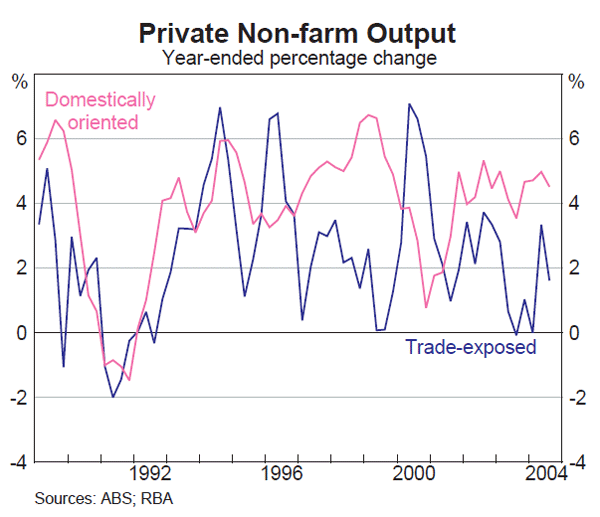
More recently, most business surveys have reported buoyant levels of activity and confidence, consistent with strong growth in domestic demand and the significant improvement in the terms of trade over the past year, though exports are an area of relative weakness in survey responses. The NAB survey of the non-farm sector reported that business conditions strengthened in the December quarter from an already high level, underpinned by buoyant levels of sales, employment and profitability. Forward orders increased firmly and capacity utilisation rose to around previous peaks, though exports remained relatively subdued. The high level of business conditions was broadly based across most industries, with particular strength in the mining and non-residential construction sectors. Conditions were expected to remain positive over the next twelve months, with high levels of employment and output. The December quarter ACCI Survey of Investor Confidence, which also covers the non-farm sector, reported a high level of current and expected business conditions.
The ACCI-Westpac survey for the December quarter pointed to strong business conditions in the manufacturing sector. The composite index of activity and the measure of capacity utilisation both rose strongly to be close to previous peaks. The AIG's Performance of Manufacturing Index, a summary measure of activity in the manufacturing sector was also above its long-run average level in January. The Sensis Business Index reported favourable conditions among small and medium businesses, with confidence about the coming 12 months remaining near an historic high.
Despite easing slightly in the September quarter, corporate profitability remains strong, with the gross operating surplus of private non-financial corporations almost 9½ per cent higher over the year. Forward-looking indicators suggest that the softness in corporate profits in the September quarter may be transitory. The NAB survey measure of actual profitability reached record levels in the months of October and November and remained high in December. After little growth in the first half of 2004, profits of unincorporated enterprises grew strongly in the September quarter, driven by a strong rise in farm profits.
The upswing in business investment seen over the past three years continued in the September quarter, with expenditure rising by 1.2 per cent (Graph 27). Growth in the quarter was again driven by a sharp increase in spending on machinery & equipment. In contrast, non-residential construction recorded a large decline, reflecting falls in both the building and engineering components. The fall in the building component was quite pronounced, as had been signalled by the shift down in the volume of work approved in late 2003 and early 2004.
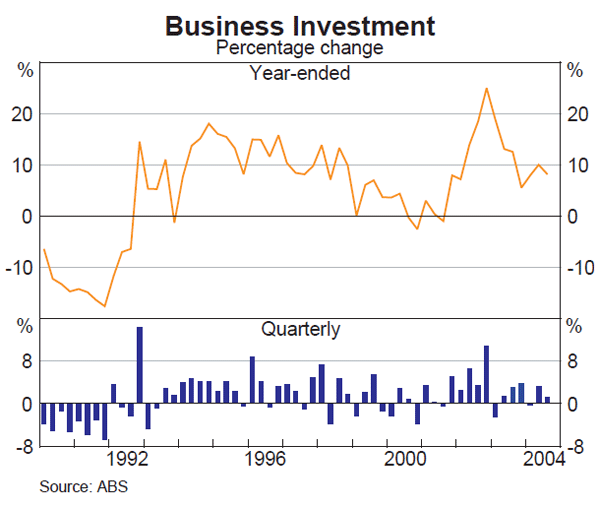
The outlook for business investment remains positive, supported by high levels of capacity utilisation and profitability. The latest capital expenditure (Capex) survey continues to point to solid growth in business investment in 2004/05, concentrated in the manufacturing, mining and property & business services sectors. The strong growth in planned expenditure in the manufacturing sector is consistent with a large value of resource-related manufacturing projects scheduled for commencement in 2004/05. When adjusted by a five-year average realisation ratio, investment intentions suggest moderate growth in expenditure on machinery & equipment. The outlook for investment expenditure on non-residential construction appears stronger overall. Activity is expected to be supported by a return to growth in engineering construction, reflecting the large value of resource-related work due to commence in 2004/05. This is expected to be partly offset by weakness in non-residential building activity, given the weakness in approvals seen in late 2003 and early 2004. The September quarter Rabobank survey suggests that farm equipment investment intentions, which are not covered in the Capex survey, remain at a high level, despite a slight decline in reported confidence in the farm sector.
Businesses' financing decisions are also consistent with the positive outlook for investment. On top of the high levels of profits and hence available internal funds, external funding seems to have picked up. Over the year to December, business credit grew by 8.7 per cent and outstanding non-intermediated debt increased by around 19 per cent. Similarly, after a period of subdued growth in early 2004, net equity raisings in the December quarter were above their average of the past five years.
Australian Government budget
The Mid-Year Economic and Fiscal Outlook (MYEFO) for 2004/05, released in December, provided a further update of the Australian Government budget position from the Pre-Election Economic and Fiscal Outlook (PEFO) in September. The projected underlying cash surplus for 2004/05 has been revised up considerably since the May Budget (Graph 28). This largely reflects a substantial upward revision to expected taxation revenue from individuals and companies, consistent with continued strength in employment and profits in early 2004/05. This upward revision to revenue was slightly offset by an increase in expected expenditure, reflecting new policy measures announced since the Budget. These new expenditure measures have resulted in the projected underlying cash surplus being revised down modestly from 2005/06 onwards.
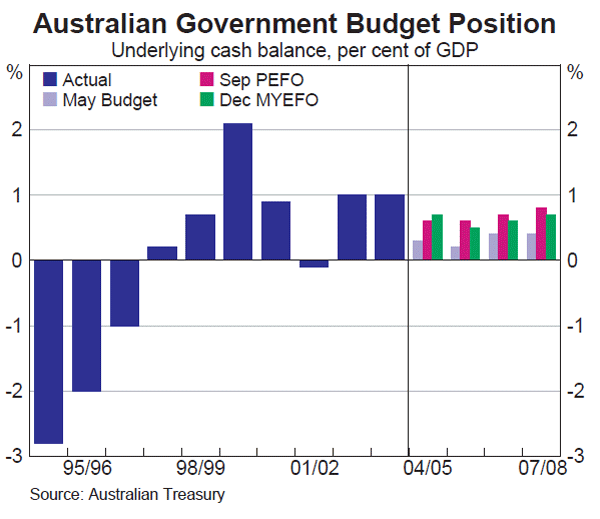
Labour market
Labour market conditions continued to improve in the December quarter. Employment grew by 1.2 per cent in the quarter, which is well above trend growth. Employment was 2.6 per cent higher over the year, and full-time employment accounted for almost three-quarters of the total increase (Graph 29). This strength in employment is somewhat at odds with the relatively weak rate of growth indicated by the national accounts.
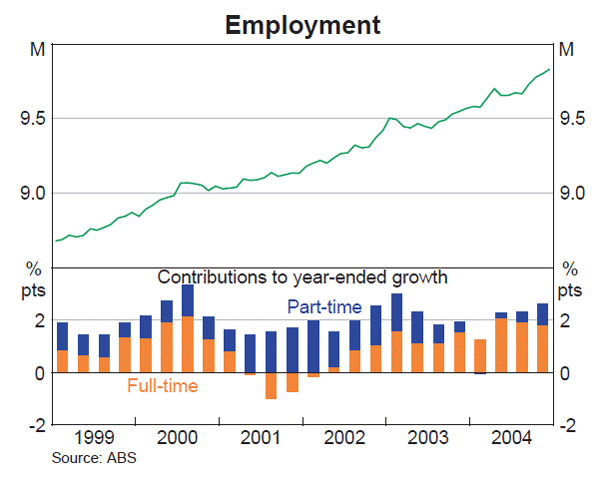
The buoyant labour market conditions in the December quarter were reflected in a further decline in the unemployment rate, which fell to 5.1 per cent in the month of December, to be 0.7 percentage points lower over 2004. This is the lowest rate recorded since late 1976. A measure of the underemployment rate, which includes employed people who want to work more hours, also reached a new low point of 6.4 per cent, a rate last seen in the December quarter 1989.[1] The participation rate increased to be 63¾ per cent in the December quarter, which is ¼ percentage point above its recent average levels.
The differences in labour market performance by state noted in the last Statement persisted in the December quarter. In New South Wales, which accounts for one-third of employment, employment growth slowed to less than 1 per cent over the year to the December quarter. All other states experienced above-trend employment growth over this period, most notably Queensland. Unemployment rates declined over 2004 in all states except Victoria. The most significant falls were recorded in Western Australia and Queensland, which now have unemployment rates of 4.5 and 4.7 per cent. By industry, the largest contributions to employment growth over the year continued to come from household services (including health & community services, accommodation, cafes & restaurants and cultural & recreational services), construction and manufacturing.
The strength in the labour market is also apparent in liaison reports, which indicate strong demand for labour and shortages of skilled workers in a range of industries and sectors, from construction and engineering to accounting and information technology. Forward-looking indicators of labour demand point to further solid employment growth in the near term (Graph 30). The ABS measure of job vacancies has continued to grow strongly, as have various internet-based vacancy series. Surveys of businesses' hiring intentions are at high levels, and print-based vacancy measures have been growing in line with the above-average growth in the labour force.
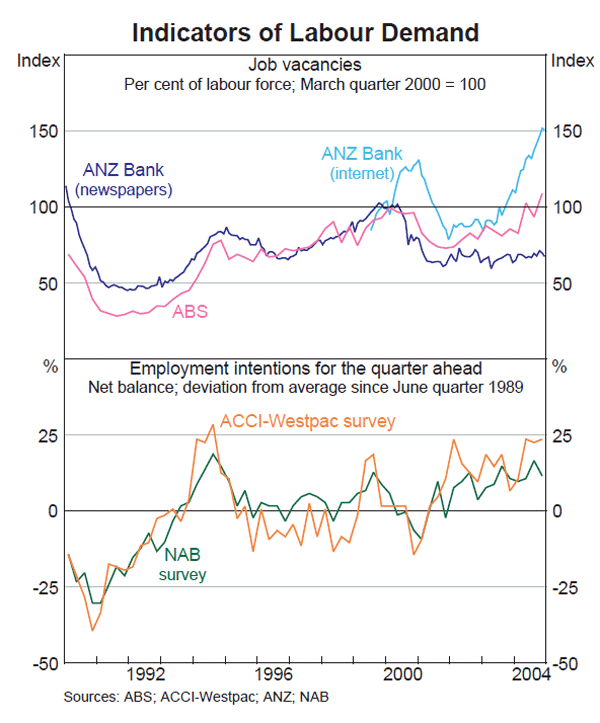
Balance of Payments
Growth in Australia's export volumes has remained weak over the past year or so, despite strong growth in global demand and world commodity prices, with total exports virtually unchanged from four years ago (Graph 31). In contrast, import volumes have expanded rapidly, buoyed by strength in domestic demand and price falls induced by a stronger exchange rate, though growth has begun to moderate more recently. A surge in Australia's terms of trade has mitigated the effect of these developments on the trade deficit, which is estimated to have been around 3¼ per cent of GDP in the December quarter 2004, wider than at mid year but broadly similar to the outturns of the past year and a half (Graph 32). The current account deficit also widened in the second half of 2004, in part reflecting a sharp increase in the net income deficit in the September quarter. The current account deficit appears likely to have remained around record levels in the December quarter at close to 6¾ per cent of GDP (assuming that the net income deficit has remained constant as a share of GDP).
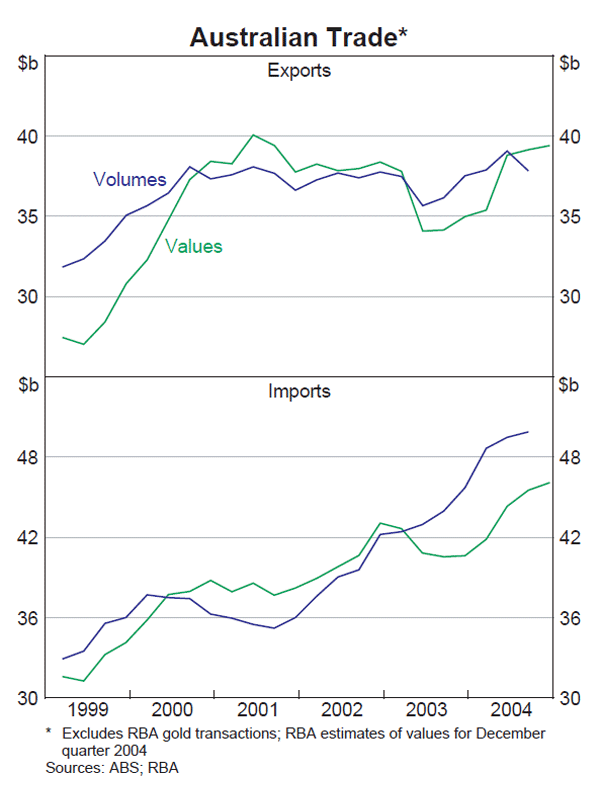
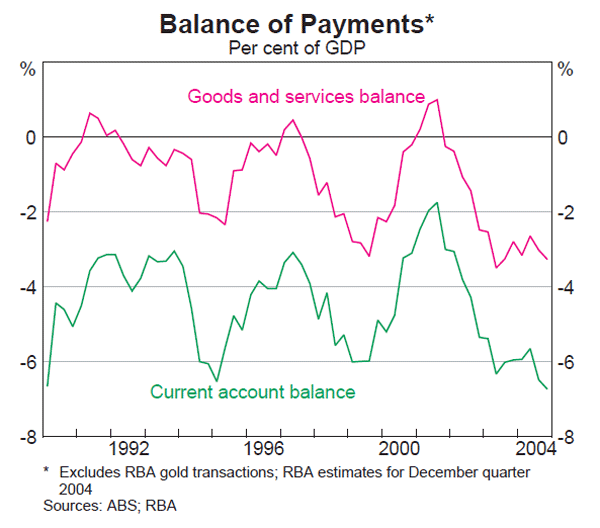
Exports
Export earnings increased by almost 15 per cent over the year to the September quarter, owing to strength in resource export prices, the recovery of rural export volumes from the drought and a pick-up in services exports following the SARS outbreak early in 2003. The pace of growth in export earnings moderated in the September quarter, however, weighed down by a broad-based fall in export volumes of 3¼ per cent. More recently, export earnings posted another modest gain in the December quarter, though with export prices declining largely on account of a stronger exchange rate in the quarter, export volumes appear to have risen.
Rural export earnings increased strongly over the year to mid 2004, as export volumes recovered from the trough associated with the drought. The upturn now appears to have run its course, with both the value and volume of rural exports falling in the September quarter (Graph 33). Furthermore, the value of rural exports fell by 12 per cent in the December quarter, implying another substantial fall in rural export volumes. Looking forward, there appears to be little prospect of near-term growth in cereals exports, given the estimated 19 per cent fall in the 2004/05 winter crop to around average levels. The outlook for livestock-based exports is more favourable, with the Australian Bureau of Agricultural and Resource Economics (ABARE) expecting an increase in export volumes in 2004/05. While the outlook for beef exports is positive, some downside risk stems from uncertainty about the timing and extent of the re-entry of US beef exports into the Japanese market, following the recent conditional lifting of BSE-related restrictions on US beef in Japan.
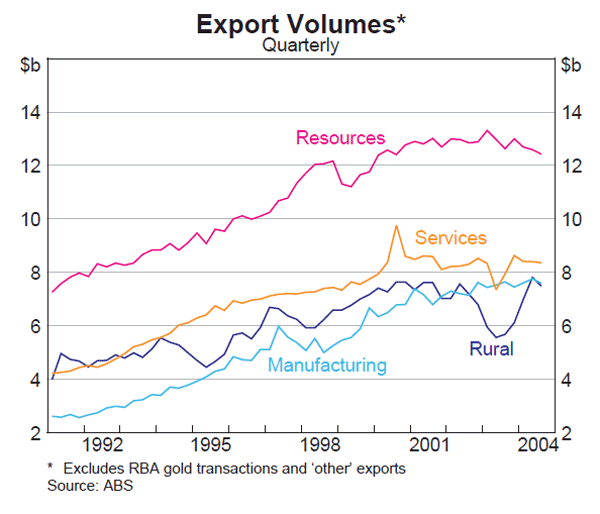
The value of resource exports has increased sharply over the past year or so, largely because of a steep rise in commodity prices. In contrast, export volumes decreased over this period, despite strong global demand, as capacity and infrastructure constraints and supply disruptions restricted growth; such supply-side factors have hampered exports for a number of years, with resource export volumes now lower than during 2000 (see the chapter entitled ‘Australia's Resource Exports – Recent Trends and Prospects’ in this Statement). Receipts from resource exports continued to rise rapidly in the December quarter; the estimated small fall in prices in Australian dollar terms points to a strong rise in resource export volumes, which would be the first increase since the December quarter 2003. This suggests that the completion of a number of mineral and energy projects is beginning to lead to higher production and exports. As noted in the next chapter, the outlook for resource exports over the next few years remains positive. Liaison reports suggest that constraints on resource exports are being alleviated as new production and transport capacity is brought on line in response to strong global demand. Ports data indicate that capacity expansions resulted in a sharp pick-up in iron ore and LNG export volumes in the December quarter; the latter pick-up reflects the recent commencement of the fourth LNG train at the North West Shelf gas project.
After a large fall in the December quarter 2003, manufactured export earnings trended upwards over 2004. The value of manufactured exports rose by 3½ per cent in the December quarter, and with a stronger Australian dollar exerting downward pressure on prices in the quarter, volumes look to have increased solidly. Nevertheless, growth in manufactured export volumes has been lacklustre since 2000. Although trading partner growth has recently been strong, firms continue to cite intense competition in export markets and the high level of the exchange rate as impediments to growth in manufactured exports. While manufactured exports from other industrialised nations have picked up since mid 2003 in response to the recovery in global demand, their overall performance since 2000 has also been quite weak, especially compared with the experience of the 1990s (Table 8). This suggests that the recent Australian experience is not altogether unusual, and may highlight a broader shift in manufacturing to developing countries such as China.
| 1990s(a) | Since 2000 | ||
|---|---|---|---|
| Canada | 12.9 | Japan | 6.5 |
| Australia | 12.0 | Sweden | 4.9 |
| Finland | 10.2 | Italy | 4.7 |
| Italy | 9.7 | Norway | 4.0 |
| United States | 7.5 | Finland | 3.2 |
| France | 6.2 | France | 3.2 |
| United Kingdom | 6.1 | Netherlands | 3.2 |
| Netherlands | 4.7 | Australia | 2.7 |
| Norway | 3.1 | United States | 2.1 |
| Sweden | 2.6 | United Kingdom | 1.9 |
| Japan | −0.1 | Canada | −0.7 |
| Average of above countries | 7.1 | Average of above countries | 3.4 |
| China | 16.7 | China | 26.1 |
|
(a) Data for several countries are not available prior to the mid 1990s Sources: ABS; CEIC; RBA; Thomson Financial |
|||
The value of services exports has fallen over the past year. This has been driven by lower export volumes, including an apparent fall in the second half of 2004 despite a firm upward trend in short-term visitor arrivals. Nevertheless, the outlook for services exports remains positive, given recent higher hotel occupancy and room rates and upbeat assessments by industry bodies of tourism prospects.
Imports
Following a surge around the beginning of 2004, which saw year-ended growth of 15 per cent, growth in import volumes eased, with imports rising by about 1 per cent in the September quarter and by an estimated 3 per cent in the December quarter. The moderation in imports growth over the second half of 2004 appears to reflect the recent decline in domestic demand growth to more sustainable rates. Capital goods imports rose by 2½ per cent in the September quarter to be 22 per cent higher over the year. And despite falls in both the June and September quarters, services imports remained 7 per cent higher over the year to the September quarter, owing to a surge in international travel by Australians in late 2003.
Net income
The net income deficit increased by about one-third over the year to the September quarter 2004, to $7.2 billion, and is running at its highest share of GDP since 1997. The widening in the net income deficit reflected increased interest payments to foreign holders of Australian debt and increased dividend payments on foreign holdings of Australian equity. The rise in payments on debt is consistent with the growth in the stock of Australian foreign debt, while the increase in payments on equity coincides with a period of strong growth in Australian corporate profitability.
Commodity prices and the terms of trade
Commodity prices have changed little on average over recent months and remain at high levels; the RBA Index of Commodity Prices fell by 0.8 per cent in SDR terms over the three months to January to be 10.2 per cent higher over the year. While rural and base metals prices were broadly unchanged over the three months to January, the prices of ‘other resources’ fell modestly (Graph 34). Commodity prices in Australian dollar terms fell by 1.9 per cent over the same period, though they also remain at high levels.
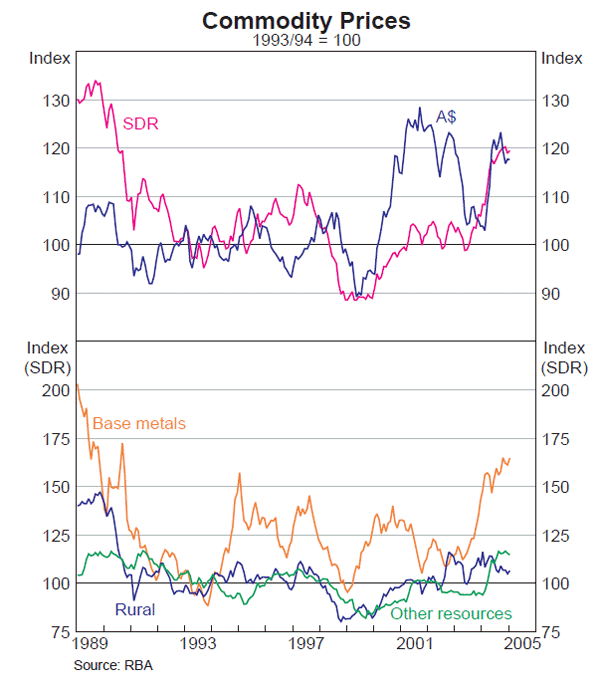
Rural prices fell marginally over the three months to January as strength in beef prices, underpinned by increased demand, was offset by lower prices for wheat and cotton, owing to recent and prospective increases in global supply. Beef prices rose to very high levels in 2004, supported by Japan's decision to ban imports of US beef following the detection of a case of BSE in the United States in late 2003. Japan has since agreed to lift the ban and allow imports of US beef from cattle that are under two years old, which is likely to place downward pressure on prices over the coming year, though it may take some time for the United States to establish systems to identify cattle age accurately.
Base metals prices were broadly unchanged over the three months to January, and at 11.2 per cent higher over the past year, they remain around the highest levels seen since 1990. Zinc prices rose by 13 per cent over the three months to January, as stronger-than-expected demand led to falls in stocks.
Prices of other resources have risen by 22 per cent over the past year, but fell by 1.3 per cent over the three months to January. Coking coal and iron ore prices, which are mostly fixed in US dollars, fell in SDR terms as the US dollar depreciated late last year. The price of gold fell by 2.4 per cent in SDR terms over the three months to January, with a sharp decline in January. Partly offsetting these falls was a rise in alumina prices as a consequence of strong aluminium demand, particularly in China, and global supply constraints, including in Jamaica following Hurricane Ivan in late 2004.
Negotiations for coal and iron ore contract prices for 2005/06 have commenced, and further large rises are expected following the steep increases in 2004/05. Some coking coal contracts have reportedly been settled at prices more than double current contract price levels. Ongoing strength in steel demand has contributed to a considerable tightening of the coking coal market. Steaming coal contract prices, which rose by over 60 per cent in US dollar terms in 2004, are expected to increase by at least another 20 per cent in the coming year. Iron ore contract price negotiations have also commenced, and price increases of over 50 per cent are possible given the current strength of global steel demand.
The terms of trade rose by 2.3 per cent in the September quarter 2004, to reach a 30-year high, and are likely to have increased again in the December quarter (Graph 35). Export prices in SDR terms have risen sharply over the past two years, buoyed by the steep rise in global commodity prices, while import prices have remained broadly flat, reflecting competitive pressures in global manufacturing. The terms of trade should increase further in mid 2005 when the anticipated higher 2005/06 contract prices for bulk commodities take effect.
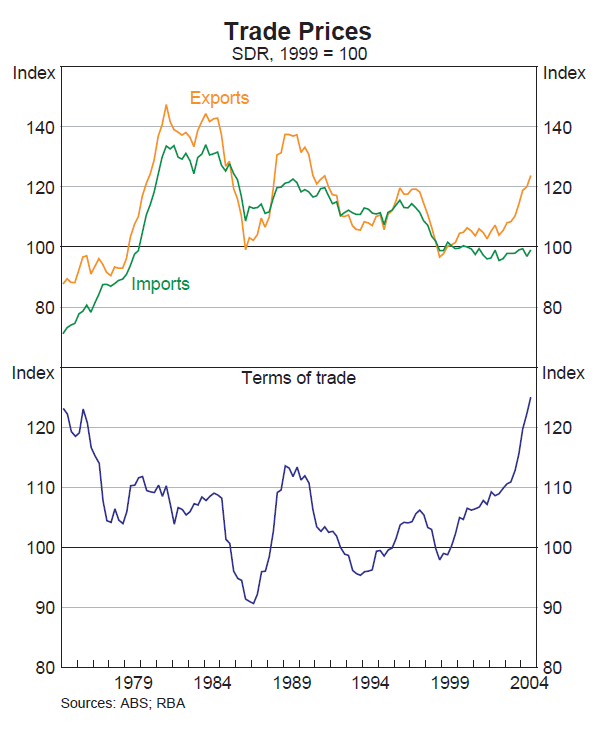
Australia's Resource Exports – Recent Trends and Prospects
After strong growth through the 1990s, resource exports have flattened out and then declined in the period since 2000. With resource exports accounting for around one-third of Australia's exports, this subdued performance has been a key contributor to the weakness in overall exports seen so far this decade. Weak world growth in the early part of the decade played an important role in reducing the demand for Australia's non-resource exports. In contrast, and as noted in the August 2004 Statement, the underperformance of resource exports since 2000 owes more to developments on the supply side. This chapter examines recent trends in Australia's resource exports, discusses the associated capacity constraints, and considers the prospects for growth.
Recent trends in resource exports
The weak export performance seen since 2000 has reflected subdued performance in all major categories of exports. However, some of the weakest outcomes have occurred in the case of resource exports, which declined over the year to the September quarter to be below the level reached in 2000, compared with average annual growth of around 6½ per cent in the 1990s (Table 9, Graph 36). The pronounced slowing in aggregate resource exports has masked diverging trends among the various components (Graph 37). The largest components – metal ores & minerals (such as iron ore and alumina) and coal, coke & briquettes (including coking and thermal coal) – have continued to increase over the past four years at similar rates to those seen during the 1990s. The weakness in resource exports has thus been concentrated in the remaining components, particularly exports of ‘other mineral fuels’ (which includes LNG and crude oil) and metals (which includes aluminium, iron & steel and copper), with exports of gold also trending lower.[2]
| Share of exports (2004) |
Average annual growth Per cent | |||
|---|---|---|---|---|
| 1980s | 1990s | 2000 to Sep qtr 2004 |
||
| Total exports | 100.0 | 4.8 | 7.5 | 0.9 |
| Rural | 19.2 | −0.2 | 5.9 | −1.6 |
| Resources(b)(c) | 32.0 | 7.6 | 6.5 | −0.1 |
| – Metal ores & minerals | 10.0 | 1.3 | 4.3 | 5.3 |
| – Coal, coke & briquettes | 8.5 | 8.0 | 5.2 | 4.9 |
| – Other mineral fuels | 5.9 | 10.4 | 11.1 | −7.7 |
| – Metals(c) | 4.7 | 4.3 | 7.1 | −4.8 |
| – Gold(b) | 3.0 | 38.3 | 5.7 | −4.3 |
| Manufactures | 19.8 | 7.8 | 12.5 | 3.8 |
| Services | 22.3 | 6.6 | 7.4 | −0.7 |
| Other(c) | 5.8 | 8.5 | 7.0 | 8.5 |
|
(a) Excludes RBA gold and frigates Sources: ABS, RBA |
||||
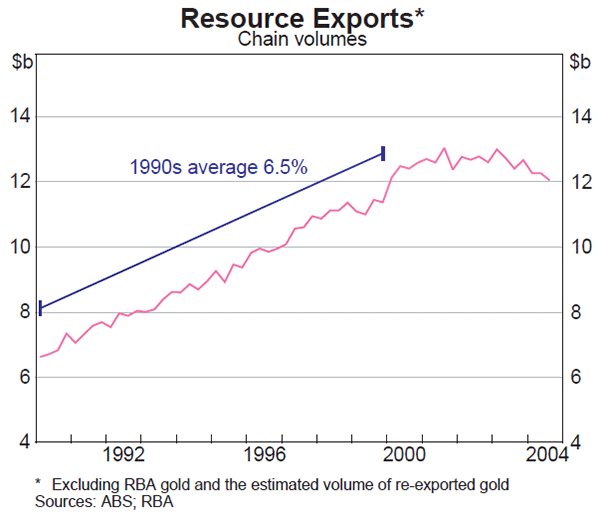

The weak performance of resource exports has continued over the past two years despite the sharp increase in global growth over 2003–2004, which has seen strong demand for resources and a surge in commodity prices. This suggests that the weakness in resource exports mainly reflects a lack of growth in aggregate supply capacity. Given the long lead times involved in putting new capacity in place, the current capacity shortfalls are primarily the result of earlier decisions, most notably the sharp downturn in investment in the mining sector in the late 1990s (Graph 38). Moreover, a number of specific factors have contributed to a decline in supply capacity for categories where exports have actually fallen:
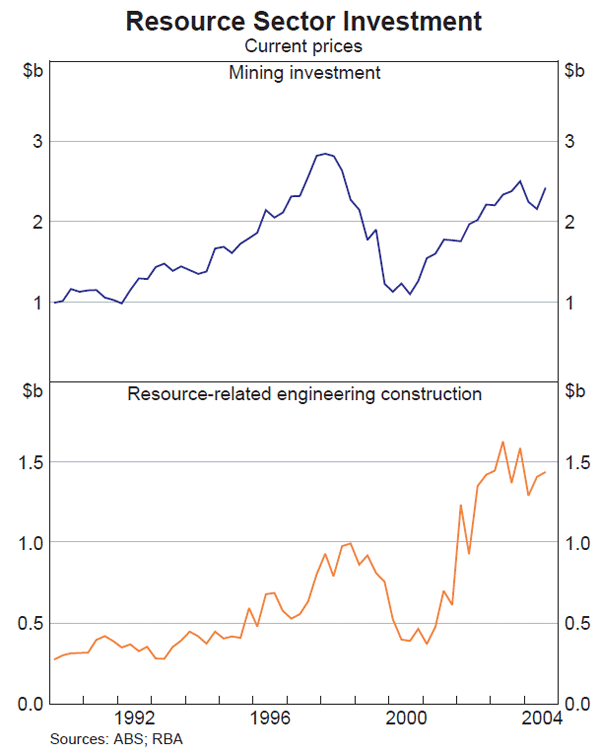
- The sharp decline in the ‘other mineral fuels’ component, comprising oil, gas and other petroleum products, reflects a drop in oil production as Australia's developed oil reserves are being depleted, with many larger oilfields approaching the end of their productive lives. Consequently, exports of ‘other mineral fuels’ have fallen by around 30 per cent since late 2000. The fall in oil exports has been only partly offset by modest growth in LNG exports.[3]
- Supply capacity for refined metals has declined because a number of refineries and mining operations were shut down after owners decided they were no longer economic, with some temporary disruptions also reducing supply.[4] Low prices for some metals in the early part of the decade, and the later appreciation of the Australian dollar, appear to have contributed to poor profitability. The closure of uneconomic refineries and mining operations is likely to have been accelerated by global consolidation, which has given major mining firms greater ability to restrain global supply. Overall, recorded exports of refined metals have declined by 28 per cent from their peak in late 2001 (though this decline is overstated by around half, as discussed in footnote 1).
- Capacity in the gold industry has declined with the closure of a number of exhausted mines since 2000.[5] Thus, gold exports have trended down over recent years, after increasing steadily through the 1990s.
Although there has been reasonable growth in the other two resource export components, particularly for iron ore, alumina and coal, the growth in these items has not been sufficient to compensate for the weakness in those components where production has fallen significantly. And even in the stronger performing components, supply constraints, including much-publicised capacity constraints in rail and port infrastructure, have begun to hamper export growth. These constraints have not played a major role in the overall weakness in resource exports so far this decade, though they have restricted the industry's ability to respond to the recent surge in world demand.
International perspective
Weak commodity prices in the late 1990s, together with consolidation in the global mining industry, appear also to have caused a global downturn in mining investment around that time; total resource-related investment in the US, Canada and South Africa declined (and was relatively flat in China), though the downturn was much less pronounced than in Australia. The resulting restraint on growth in global capacity is likely to have contributed to the recent surge in world prices for commodities as global demand has strengthened. Further, the sharp turnaround in mining investment in Australia since 2000 (discussed below) appears also to have been matched elsewhere around the world, particularly in the US and China. This points to a significant expansion in global capacity in coming years, and the possibility that recent large commodity price increases may be partly reversed as global supply expands.
In line with the sharper downturn in mining investment, growth in Australia's resource exports has generally lagged behind that of other large commodity exporters in recent years (Graph 39). The value of mineral exports from six major exporters grew by 76 per cent in US dollar terms between 1999 and 2003, compared with growth of 34 per cent for Australia over the same period. However, consistent with the data in Table 9, this relative underperformance appears to be confined to only a few types of commodities. In particular, Australia has generally not lost market share in global trade for our major resource export commodities (Graph 40). However, the decline in Australia's share of global crude oil production has been pronounced, and is expected to continue, with the share of global gold and copper production also generally declining over recent years.
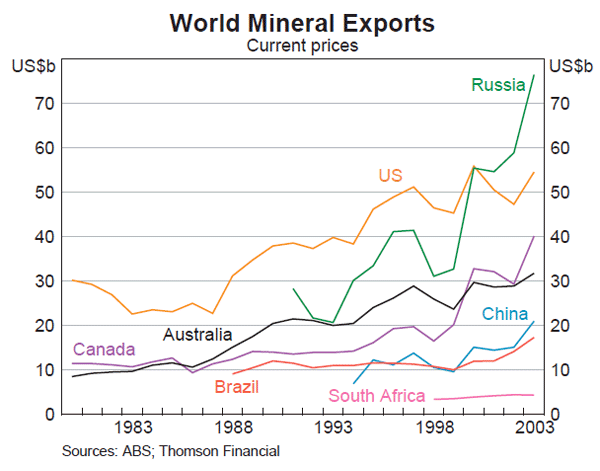
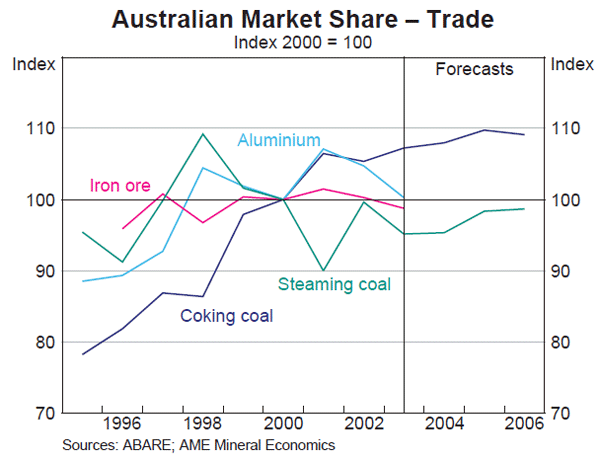
Prospects for growth
Mining capacity
Following the downturn in the late 1990s, mining investment in Australia has increased substantially (refer Graph 38). This was initially spurred by a sharp lift in Australian dollar commodity prices and mining profits, buoyed in part by a large depreciation in the exchange rate. The resurgence in global demand and world commodity prices from 2003 has since provided further impetus to resource-related investment. Given the long lead times for resource projects, this earlier investment is expected to result in significant expansions in mining capacity in the current financial year and in 2005/06. Data from Access Economics indicate that the value of completed resource projects is set to rise significantly in 2004/05, and remain relatively high in 2005/06, reflecting large increases across a range of commodities (Graph 41).[6]
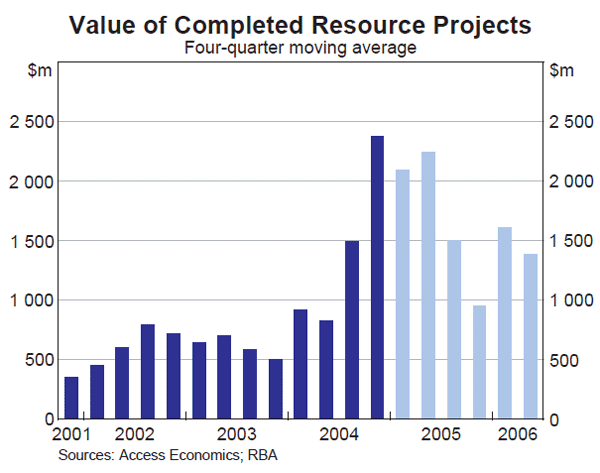
In addition, a detailed survey of impending capacity expansions across 14 commodity groups paints a similar picture of substantial growth in capacity over the next few years. This exercise, as summarised in Table 10, is based on information from ABARE, Access Economics and various company sources. Although there is substantial uncertainty over the timing and size of expansions, the analysis suggests that new capacity coming on stream between mid 2004 and 2007 would imply an increase in overall production of around 28 per cent from the levels of 2003/04, corresponding to annual growth of about 9 per cent. While solid growth is expected in each of the next three years, the most significant increase in capacity is expected to occur in 2005/06. The actual increase in capacity that occurs over this period will also be affected by cancellations of some planned projects, the addition of new projects that are in preliminary stages of planning or not yet planned, and most importantly, on the loss of some existing capacity from closures owing to low profitability or depletion of resources. Accordingly, the net increase in capacity appears likely to be less than that implied by Table 10. While there is considerable uncertainty around any particular estimate, the analysis nevertheless suggests that substantial growth in mining capacity and resource export volumes is in prospect for at least the next few years.
| Commodity | Growth from new capacity Per cent |
Annualised growth from new capacity Per cent |
Decline in existing capacity(a) |
|---|---|---|---|
| Crude oil & condensates | 45 | 13(c) | Very significant |
| LNG | 98 | 25(c) | None |
| LPG | 34 | 16(b) | significant |
| Thermal coal | 16 | 8(b) | Very modest |
| Coking coal | 18 | 6(c) | Very modest |
| Iron ore | 53 | 15(c) | Very modest |
| Alumina | 24 | 7(c) | Very modest |
| Gold | 23 | 11(b) | Modest to significant |
| Aluminium | 4 | 1(c) | } No plant closures forecast |
| Iron & steel | 13 | 4(c) | |
| Estimated total(d) | 28 | 9(c) | – |
|
(a) Staff assessment Sources: RBA staff; based on ABARE and Access Economics project listings, and company announcements |
|||
In the case of those commodities where there has been reasonable growth in recent years, there would appear to be good prospects for further increases in production and exports. For example, there should be substantial new capacity, with limited declines in existing capacity, for several major export commodities, including coal, iron ore, alumina and especially LNG, with growth in the latter significantly boosting exports in the December quarter 2004.
Furthermore, there would appear to be some increases in production in prospect for the commodity groups that have contributed most to export weakness in recent years. In the case of gold and other metals, new capacity is expected to come on stream in the near future, and a number of temporary problems that have restrained production are likely to have been resolved, or be nearing resolution. In addition, given the strength of global demand and commodity prices, mine or plant closures are expected to be fairly limited, with ABARE in fact predicting that some closed mining and refining operations will be re-opened in response to the current favourable conditions. In the case of crude oil & condensates, it is expected that significant new capacity will come on stream over the next two years or so, and that this will initially outweigh declines in production from existing oilfields. However, the underlying constraints in oil reserves are expected to re-emerge after a few years, with both ABARE and Geoscience Australia expecting oil production to decline again after 2007.
Transport infrastructure
The ability to expand exports will depend not only on production capacity, but also on the capacity of rail and port infrastructure. Over the past year, concerns have emerged that a lack of capacity in transport infrastructure is constraining the ability of the resources industry to expand export supply. Transport infrastructure constraints are primarily an issue for bulk commodities such as coal and metal ores; the volume of these commodities transported is large compared with processed minerals, and strong growth in recent years has stretched existing transport capacity. Exports of processed metals do not place a large burden on domestic port and rail capacity, while oil and LNG are usually exported from the fields directly.
Expansion of export supply capacity for bulk resources requires coordinated investment in transport infrastructure as well as mine capacity. Data from Access Economics suggest some increase is under way in overall investment spending on rail and port projects. However, it is difficult to ascertain directly from these data if this will alleviate specific capacity constraints in bulk export supply chains.
To examine transport infrastructure developments more closely, a detailed survey of the infrastructure associated with major coal and iron ore ports was undertaken. Overall, the analysis, which is summarised in Table 11, suggests that transport bottlenecks have hampered growth in these stronger performing export categories over the past year. However, investment in additional infrastructure is occurring, with the planned expansions likely to support strong growth in iron ore exports, while growth in coal exports is expected to be more moderate.
| Port | Current throughput(a) (Mtpa) |
Port capacity (Mtpa) |
Committed expansion projects by 2007 |
|
|---|---|---|---|---|
| Port | Rail | |||
| Coal | ||||
| Hay Point (Qld) | 87 | 90 | Minor | Major |
| Newcastle (NSW) | 76 | 89 | Minor | Major |
| Gladstone (Qld) | 43 | 45 | Major | Major |
| Other | 23 | 32 | – | – |
| Australia | 229 | 256 | 32 (Mtpa)(b) | |
| Iron ore | ||||
| Port Hedland (WA) | 98 | 100 | Major | Minor |
| Dampier (WA) | 75 | 80 | Major | Minor |
| Cape Lambert (WA) | 39 | 52 | – | Major |
| Other | 7 | 8 | Minor | – |
| Australia | 219 | 240 | 36 (Mtpa)(b) | |
|
(a) Six-months annualised to latest available Sources: ABS; state government and company announcements |
||||
In the case of coal, while the capacity of port and rail infrastructure has become stretched with the latest surge in global demand, the industry has been expanding transport capacity steadily over recent years. Since 2000, the capacity of coal export ports is estimated to have increased by around 19 per cent, with expansions occurring at the Hay Point, Newcastle and Gladstone ports, which together account for over 90 per cent of Australia's coal exports. However, the Newcastle port operator's decision to introduce a quota system to allocate transport chain capacity and reduce the ship queue is one illustration that provides clear evidence that a shortage of transport capacity is limiting the industry's ability to meet strong growth in coal demand. In the case of Newcastle, exports are running below port capacity and bottlenecks appear to be concentrated in the rail network. For the two major Queensland supply chains, the ports are operating close to capacity and investment in both port and rail facilities is necessary to allow export growth.
According to currently available information on planned coal port expansions, committed investment will increase port capacity by an estimated 13 per cent over the next two years or so. Growth in rail capacity is expected to be broadly in line with the expansion of port capacity. However, this is unlikely to match the expansion in production potential or export demand, so transport capacity is likely to remain a constraint on export supply, at least until a number of proposed large infrastructure projects are completed later in the decade. For example, a significant increase in the capacity of the Hunter Valley coal chain is unlikely until completion of major rail infrastructure projects to eliminate the bottleneck at the intersection of the coal and commuter networks. In Queensland, as discussed below, there is considerable uncertainty surrounding a proposed expansion of the Dalrymple Bay coal terminal at Hay Point.
One feature hindering investment in both the NSW and Queensland coal industries is the fragmented ownership of the supply-chain assets; a large number of mines share mostly state-government-owned rail and port infrastructure. Transport infrastructure is generally operated not by the coal mining companies, but by public or privately owned third parties who are responsible for new investment, some of which are subject to regulatory control owing to the monopolistic nature of the assets. In the case of Dalrymple Bay, a major longer-term expansion of capacity is uncertain given that it has been reported that investment in new capacity is contingent on an increase in the allowable user charge, whereas the Queensland Competition Authority (QCA) has proposed that user charges be lowered. The operator has deferred a decision on further investment until the QCA hands down its final ruling in April.
In the case of iron ore, there are fewer coordination problems, as the industry is more concentrated, with two companies controlling three vertically integrated supply chains accounting for over 90 per cent of exports. The consolidated structure of the iron ore industry, and geographic separation from competing economic activities, appear to have facilitated a rapid pick-up in transport capacity in response to strong global demand and prices. Accelerated investment in ship-loading and rail capacity has been undertaken over the past year to match expanding iron ore production. Port capacity is estimated to have increased by 19 per cent since 2003, more than sufficient to support recent growth in iron ore exports. Company announcements suggest that another 15 per cent increase in transport capacity will come on line in the next two years, with further substantial expansion planned for later in the decade.
Exploration
Beyond the reasonably favourable outlook for the next few years, growth in productive capacity and exports in the resources sector over the longer term will depend on future mineral discoveries (though existing reserves could support production and exports of some commodities, such as coal, for a considerable time). However, developments in exploration expenditures are not especially encouraging. Although there has been a modest pick-up recently, levels of spending on mineral and petroleum exploration are both below the peaks seen in 1997, and indeed as a percentage of GDP are currently around the lowest levels seen for at least 25 years (Graph 42). This suggests that growth in Australian resource production and exports over the longer term could be at risk without an ongoing lift in exploration spending.
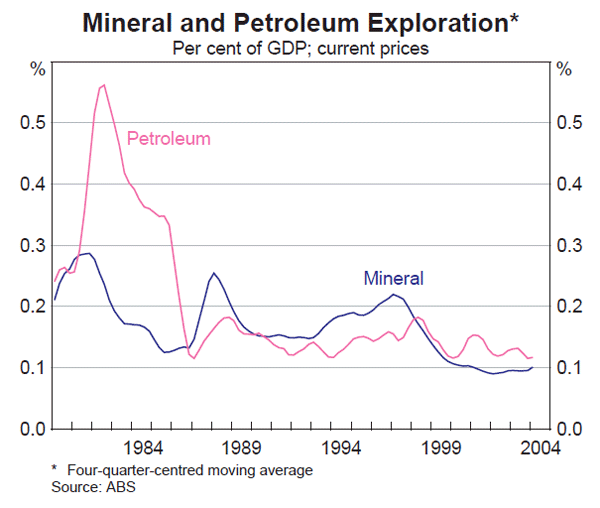
There is some evidence that weakness in Australian exploration in recent years has mirrored global trends. Data from sources such as the Metals Economics Group (MEG) in Canada and Price Water house Coopers suggest that global spending on exploration has been relatively weak in recent years, following a sharp fall in the late 1990s. Indications are that global exploration spending is now beginning to recover, in line with the Australian experience, though it appears to have outstripped the relatively muted rise in exploration expenditure in Australia to date.
Summary
The current strength in aggregate investment in resources suggests that a sustained pick-up in Australia's resource production and exports is likely, a conclusion supported by a detailed analysis of planned increases in production capacity for 14 major export commodities. The implied increase in overall resources production over the next three years, if realised, would facilitate resource export growth over the next few years at about the same pace as seen in the 1980s and 1990s. In the case of the bulk commodities, growth in exports will require substantial growth in rail and port capacity, much of which is under way or committed. However, in the case of coal, major increases in export capacity will require better coordination between producers, infrastructure operators and governments, especially in respect of the financing and pricing of new transport infrastructure.
Finally, it is worth considering the broader implications if Australia and other major resource exporters are successful in easing capacity constraints and in increasing export volumes. In particular, it is likely that the recent sharp increases in commodity prices – the steep rises in coal and iron ore prices being the most noteworthy cases – would not be sustained if global supply was increased substantially. The consolidation of the global resources industry may help to reduce the ‘cobweb cycles’ (or ‘hog cycles’) that periodically occur in commodity markets, but they are unlikely to eliminate such cycles entirely. Thus it would seem quite possible that at some stage in the next few years, there could be some retracement of the current strength in resource commodity prices and Australia's terms of trade.
Domestic Financial Markets
Interest rates and equity prices
Money and bond yields
For a time following the previous Statement, short-term market yields in Australia fell. This was mainly in response to a number of weaker-than-expected data releases, including the GDP figures. More recently, however, yields have been rising again, as the run of economic data has been of a stronger tone (Graph 43). Yields rose further in late January after the release of the CPI statistics, which showed that inflation was higher than most market participants expected. Short-term yields have risen by about 15 basis points from their December quarter lows, as the market has again moved to price in a possible monetary tightening, though not in the immediate future.
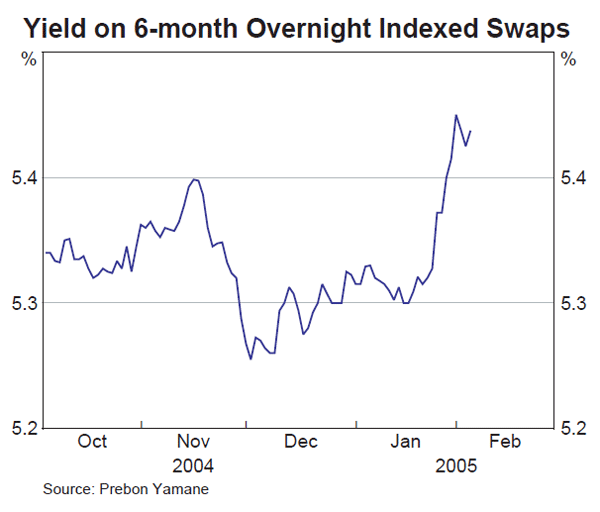
Long-term yields have followed a pattern similar to that in short-term yields. From around 5.4 per cent at the time of the previous Statement, yields on 10-year bonds fell to a low of 5.1 per cent in mid December, but have since risen back to near 5.4 per cent. These swings in bond yields were for the most part driven by domestic news rather than international events. In fact, for much of the period when Australian bond yields were falling, US yields were rising. This led to quite a sharp narrowing in the spread in bond yields between the two countries, from around 130 basis points at the time of the previous Statement to a low of 85 basis points in early December. Since then, the spread has returned to around 120 basis points.
There has been little change in the market's perceptions of credit risk during the past three months. Spreads between corporate bond yields and swap rates and the premia on credit default swaps have fallen slightly over the period, and are very low by historical standards (Graph 44). While the low level of credit spreads in Australia (and in other major bond markets) largely reflects favourable trading conditions for corporates, there is evidence that the search for yield has been a contributing factor. In Australia, this has been evidenced by institutional investors having greater-than-index weight exposure to non-government bonds. Australian retail investors have also increased their (effective) exposure to corporate debt, via the purchase of listed, synthetic collateralised debt obligations (CDOs).[7]
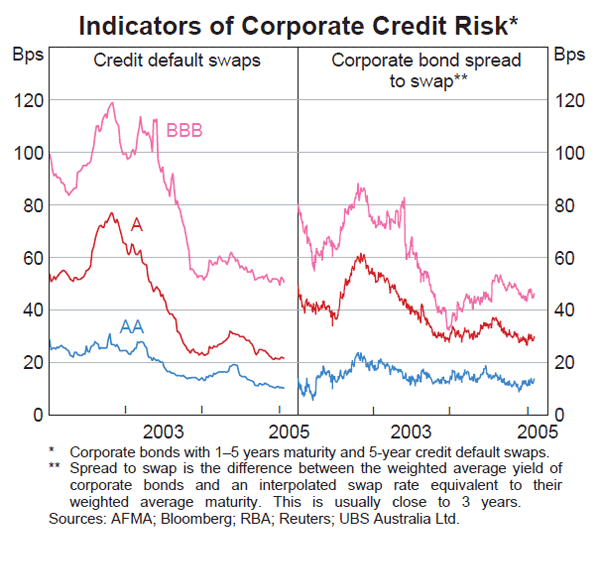
Intermediaries' interest rates
Intermediaries' variable indicator lending rates are unchanged since the previous Statement, consistent with there having been no change in the cash rate. Interest rates on fixed-rate housing loans have fallen by around 5 basis points over the same period, bringing the cumulative decline since late September 2004 to 35 basis points (Graph 45, Table 12). The major banks' average 3-year fixed housing rate is currently 6.60 per cent, 45 basis points below their average standard variable rate. This widening in the gap between fixed and variable housing rates is likely to have contributed to the pick-up in the proportion of borrowers choosing to take out fixed-rate housing loans: in November 2004, the latest available data, 11 per cent of new owner-occupier housing loan approvals were at fixed rates, up from 7 per cent three months earlier and the highest share since the beginning of 2004, which followed a period of monetary policy tightening (Graph 45).
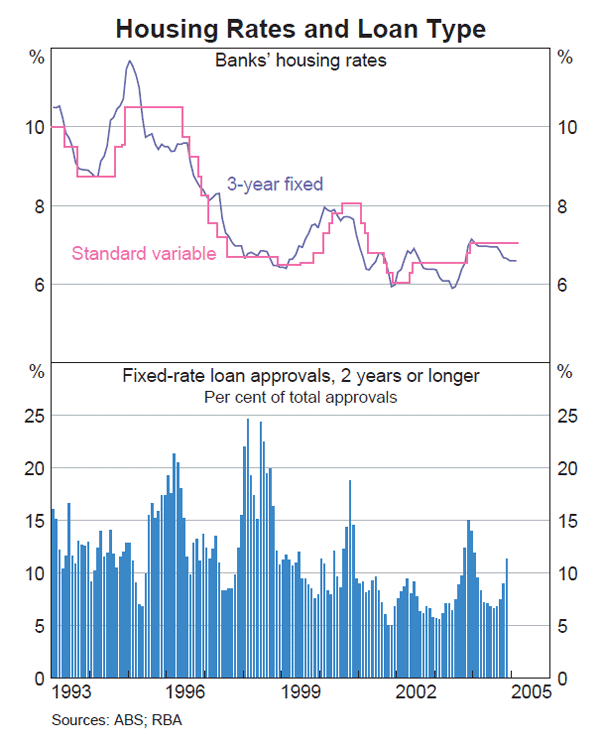
| Variable rates – households | Variable rates – business | Fixed rates (3 years) | |||
|---|---|---|---|---|---|
| Mortgages: | Small business | – Housing | 6.60 | ||
| – Standard variable | 7.05 | Residential security: | – Small business | 7.35 | |
| – Basic housing | 6.50 | – Overdraft | 7.95 | – Swap rate | 5.70 |
| – Mortgage managers | 6.70 | – Term loan | 7.25 | ||
| Personal lending: | Other security: | ||||
| – Residential security | 7.20 | – Overdraft | 8.85 | ||
| – Credit cards | 16.45 | – Term loan | 7.85 | ||
| Large business | |||||
| – Overdraft | 8.85 | ||||
|
Source: RBA |
|||||
Fixed rates on loans to small businesses have been broadly unchanged in net terms since the previous Statement, having fallen by 15 basis points in total since around the middle of 2004. The movements in fixed housing and small business lending rates over this period have been broadly consistent with the movements in banks' costs of funding these loans.
Equity prices
Australian share prices have risen by 10 per cent since the previous Statement and reached a series of record highs during the period (Graph 46). The Australian market continued to outperform the S&P 500 and MSCI World indices, which both rose by about 6 per cent. The ASX 200 rose by 23 per cent over 2004, the largest calendar-year increase since 1993 and more than double the rise in the S&P 500 and MSCI World indices over the year.
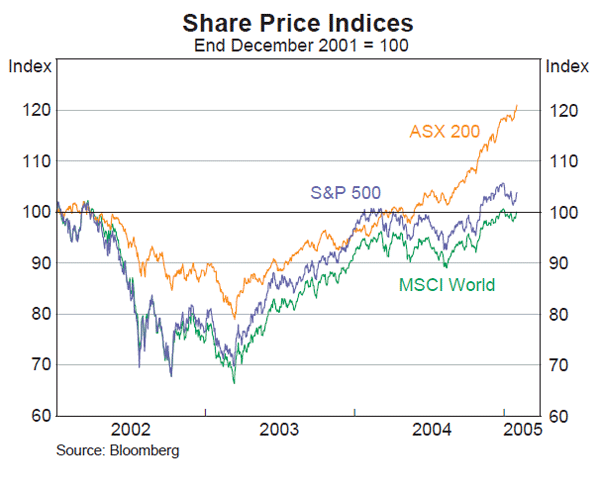
The increase in the ASX 200 since the previous Statement has been broad-based, with all 10 market sectors and three-quarters of individual companies' share prices having risen (Graph 47). The materials sector has risen by 16 per cent, boosted by continuing strength in base metals prices and expectations of substantial increases in contract prices for coal and iron ore. The industrials sector (up 13 per cent) and consumer staples sector (up 7 per cent) have been supported by significant merger and acquisition activity.

In aggregate, the rise in share prices since the time of the previous Statement has outstripped growth in dividends and earnings. Dividend yields have fallen by 0.2 percentage points to 3.4 per cent, having been around 4 per cent a year earlier, and the price/earnings (P/E) ratio has risen from 19 to 21, compared with a 40-year average of around 15 (Graph 48). The 12-month forward P/E ratio has also risen, despite some upward revision to earnings forecasts.
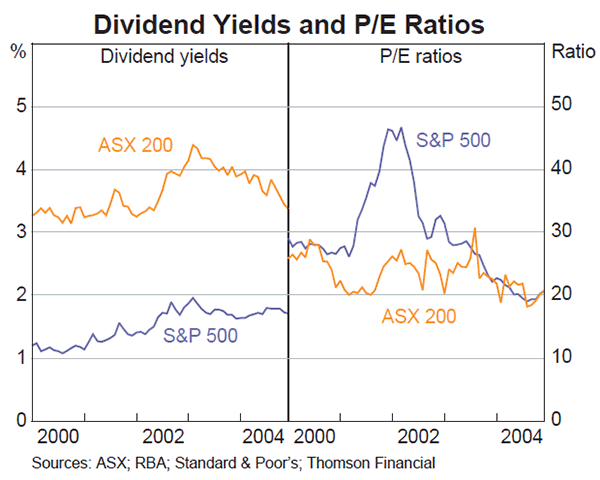
Margin lending for direct purchases of equities and placements with managed funds rose by 5 per cent in the December quarter, to $15.2 billion. Growth over the year was 21 per cent, up from 15 per cent over the previous year. Much of the recent growth in margin debt has reflected an increase in the average loan size, which has risen by around $13,000 to $107,000 over the past year. Average leverage is still relatively low, however, mainly owing to the strength in the share market, which has boosted the value of assets underlying margin loans.
Financing activity
Debt markets
Australian non-government entities issued $28 billion of bonds in the December quarter, well below the $42 billion average issuance seen in the first three quarters of 2004 (Table 13). The slowdown in the December quarter was evident mainly in offshore markets.
| Sector | 2001 | 2002 | 2003 | 2004 | 2005 | |
|---|---|---|---|---|---|---|
| of which December quarter |
January | |||||
| Bond issues by Australian entities | ||||||
| Onshore | ||||||
| Financial institutions | 6.0 | 7.4 | 9.8 | 14.0 | 3.6 | 1.2 |
| Non–financial corporates | 5.9 | 7.6 | 4.9 | 8.0 | 3.6 | 0.0 |
| Asset–backed | 15.0 | 19.3 | 21.2 | 25.0 | 4.0 | 2.2 |
| Total | 26.9 | 34.3 | 35.9 | 46.9 | 11.2 | 3.3 |
| Offshore | ||||||
| Financial institutions | 29.3 | 31.8 | 49.2 | 64.1 | 10.1 | 3.8 |
| Non–financial corporates | 6.8 | 10.5 | 15.3 | 14.1 | 6.6 | 0.3 |
| Asset–backed | 14.3 | 16.5 | 24.3 | 29.8 | 0.1 | 4.6 |
| Total | 50.4 | 58.9 | 88.9 | 108.1 | 16.8 | 8.6 |
| Total | 77.3 | 93.2 | 124.7 | 155.0 | 28.0 | 11.9 |
| A$ bond issues by non-resident entities | ||||||
| Onshore | 7.8 | 3.1 | 7.1 | 21.1 | 5.0 | 1.0 |
| Offshore | 4.3 | 17.3 | 24.4 | 21.7 | 5.3 | 1.3 |
| Total | 12.1 | 20.4 | 31.5 | 42.8 | 10.4 | 2.3 |
|
Source: RBA |
||||||
Asset-backed vehicles issued only $4 billion of bonds in the December quarter, less than a quarter of their average issuance in the first three quarters of 2004. The decline in issuance was sharper than can be readily explained by seasonality and the fall in housing loan approvals in 2004 and appears to have been driven by a fall in issuer supply rather than investor demand, given that primary spreads have narrowed by at least 5 basis points over the period, to historically low levels. Issuance was robust in January but market contacts don't expect issuance in 2005 to be as strong as that seen in 2004.
Financial institutions' bond issuance was also weaker in the December quarter, particularly issuance in offshore markets. In contrast, non-financial corporates, led by property trust and infrastructure companies, issued a record $10 billion of bonds.
Non-residents issued $10 billion of Australian-dollar denominated debt in the December quarter. Foreign financial institutions led the issuance in Australia, while supranationals and foreign government agencies accounted for most of the offshore Australian dollar issuance.
Total issuance of bonds in the domestic market by all non-government borrowers was $68 billion in 2004, up 60 per cent on 2003, with half of this increase accounted for by increased issuance by non-residents. This strength in gross issuance has led to a sharp increase in non-government bond outstandings. Over the year, non-government bond outstandings rose by $34 billion to $176 billion. The Commonwealth Government's bond outstandings were little changed at $52 billion, while the state governments' bond outstandings rose slightly to $56 billion (Graph 49). Non-government bonds presently account for around 60 per cent of domestic bond outstandings, compared with only 14 per cent a decade ago.
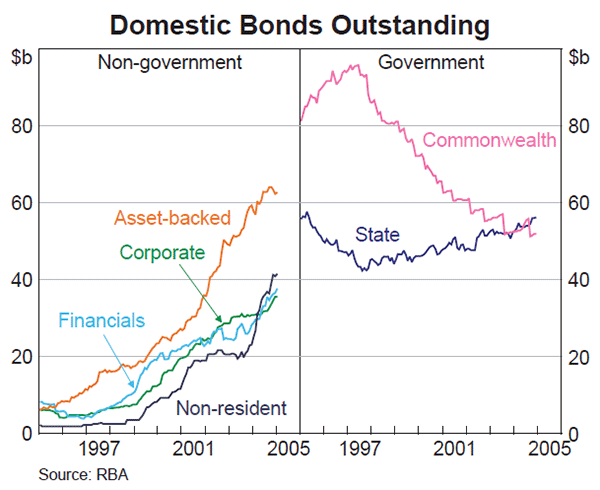
Hybrid raisings
Australian entities' issuance of hybrid securities picked up in the second half of 2004 after slowing noticeably during the first half because of issuer uncertainty about how hybrid securities would be classified under new accounting standards. Since the previous Statement, non-financial and financial institutions have each issued almost $1½ billion of hybrid securities. Financial institutions continue to be the main driver of innovation in the market. IAG issued the first reset-exchangeable security in the domestic market. (These are reset securities combined with an option that allows the issuer to convert the securities to preference shares but subsequently pay a higher coupon rate if not converted to ordinary equity or redeemed within 10 years.) Also, ANZ became the first Australian entity to issue a euro-denominated hybrid while Rabobank became the first non-resident issuer of hybrid securities in the domestic market.
Equity raisings
Net equity raisings totalled $7.8 billion in the December quarter, about one and a half times the quarterly average since the start of 2000 (Graph 50). Equity raisings via initial public offerings (IPOs) were particularly strong, with 53 companies raising in excess of $3 billion in total (compared with around $1 billion per quarter, on average, since the start of 2000). Companies in the financials and industrials sectors accounted for almost two-thirds of the value of IPO capital raised. The large amount of equity raised was offset to some extent by a sharp increase in the value of buybacks in the quarter. This result was driven by BHP Billiton's and Telstra's buybacks in December.
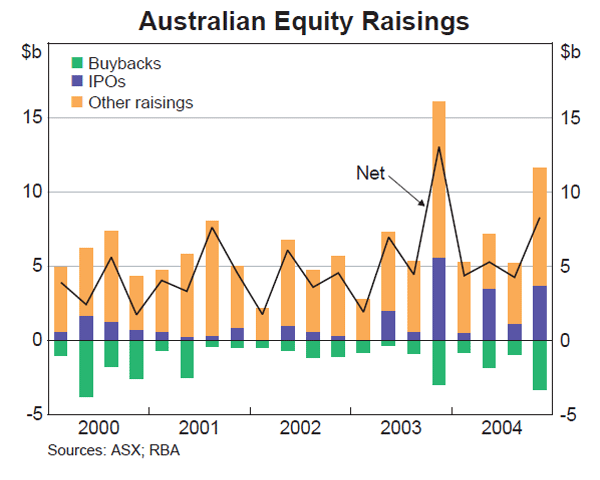
For non-financial corporates, total net non-intermediated capital raisings (that is, issuance of short and long-term debt securities, hybrids and equities, all net of maturities/buybacks) reached record levels in the December quarter. For the second half of the year, net raisings amounted to $23 billion, around double the half-yearly average since 2000.
Merger and acquisition activity by Australian companies remained strong in the December quarter. In the second half of 2004 there were almost $50 billion of completed and pending transactions (Graph 51). This was well above the $36 billion recorded in the first half of 2004, which included the $27 billion Westfield merger, and more than triple the semi-annual average since 1995. Market participants have attributed the increase in merger and acquisition activity to rising equity prices, strong company profitability and a strong economy, both domestically and globally.
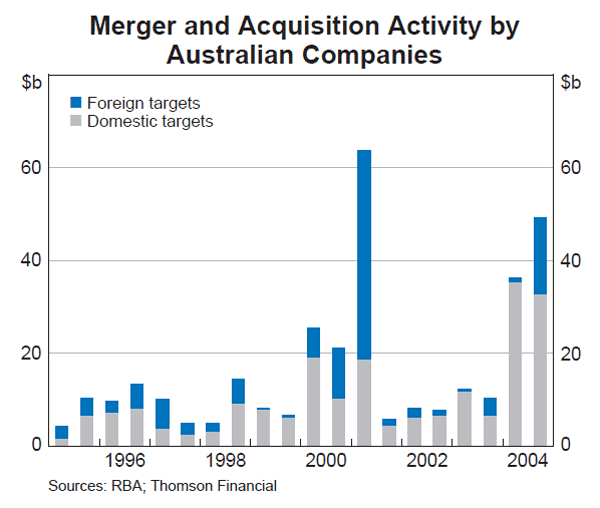
Financial Conditions
Financial conditions continue, on balance, to be supportive of domestic economic growth. Both nominal and real interest rates are marginally below their average levels of the past decade. The real exchange rate has appreciated in recent months, but the strong terms of trade are likely to have offset its contractionary effects. There have also been strong gains in equity markets during 2004 and total credit growth still remains relatively strong.
The cash rate has remained at 5.25 per cent for over twelve months. Household and business variable lending rates have also remained constant, and below their averages of the past decade. In addition, as discussed in the chapter on ‘Domestic Financial Markets’, Australian bond yields remain relatively low, despite having risen a little recently. Real interest rates implied by the yields on indexed bonds, as well as the real lending rates derived using various measures of inflation expectations, are also slightly below their long-term averages. In real terms, the trade-weighted exchange rate is around 12 per cent above its average over the post-float period (Graph 52).
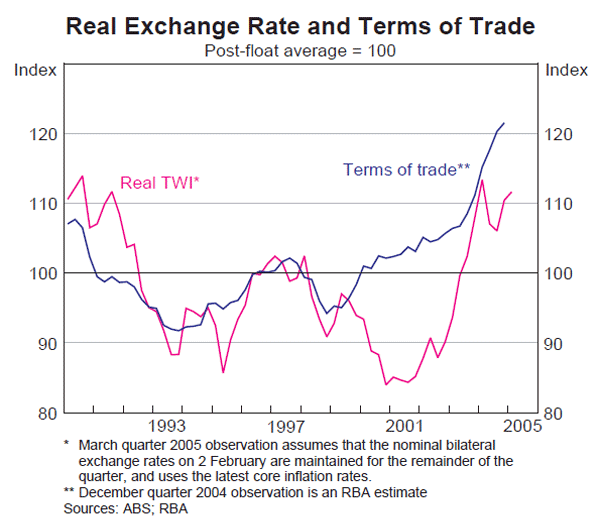
Total credit growth remains high, at an annualised rate of 12.3 per cent over the six months to December, but has eased substantially from the peak seen around the end of 2003 (Table 14 and Graph 53). This slowing is attributable to the household credit component, which expanded at an annualised rate of 13.2 per cent over the same period, compared with the peak a year previously of more than 21 per cent.
| Six-month-annualised | |||
|---|---|---|---|
| December 2003 | December 2004 | Year-ended December 2004 |
|
| Total credit | 17.0 | 12.3 | 12.5 |
| Household | 21.3 | 13.2 | 14.8 |
| – Housing | 22.5 | 12.6 | 14.9 |
| – Personal | 15.4 | 16.3 | 14.4 |
| Business | 10.4 | 10.8 | 8.7 |
| Broad money | 14.4 | 11.0 | 9.4 |
|
Source: RBA |
|||
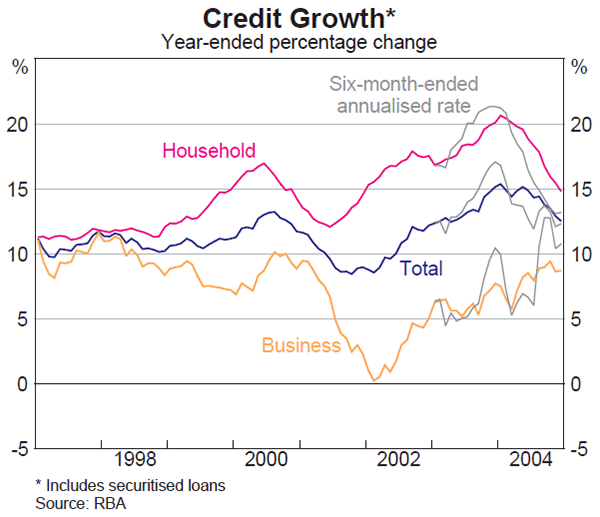
Both housing credit and non-housing personal credit growth moderated in the first half of 2004, but only housing credit continued this trend into the second half of the year. The pace of growth in housing credit nonetheless remains brisk, and now appears to have stabilised, at an annual rate of around 12½ per cent over the six months to December. The rate of growth in housing credit is consistent with the rate that would be expected given the level of loan approvals. This follows a period in 2002 and 2003 when it was stronger than would have been suggested by the prevailing level of loan approvals, perhaps partly reflecting a greater than usual amount of redrawing of funds from existing housing loans. Personal credit recorded strong growth over the second half of 2004, with the fixed-term loan component picking up in response to strong demand for new motor vehicle finance; growth in revolving credit has been broadly stable.
Year-ended business credit growth remains more moderate than that for household credit, but in contrast to the slowing in household credit growth, it has continued on the broad upward trend evident over the past few years. Combined with the current high level of business loan approvals and robust capital market raisings in recent months, this suggests that businesses are still finding it quite easy to obtain finance.
Inflation Trends and Prospects
Recent developments in inflation
The Consumer Price Index (CPI) rose by 0.8 per cent in the December quarter to be 2.6 per cent higher than a year earlier (Graph 54). Petrol price increases continued to make significant contributions both in the quarter and over the year; excluding petrol, the CPI increased by 2.0 per cent over the year to December. Based on a range of different indicators of underlying inflation, the Bank's assessment is that underlying inflation was around 2¼ per cent in year-ended terms (Table 15).
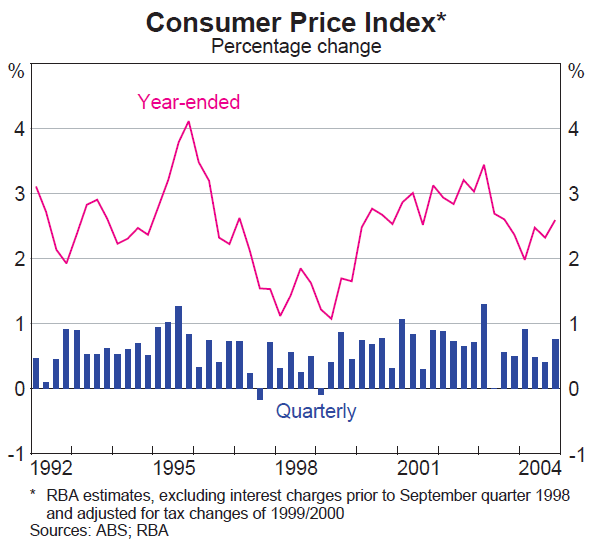
| Quarterly | Year-ended | ||||
|---|---|---|---|---|---|
| September quarter 2004 |
December quarter 2004 |
September quarter 2004 |
December quarter 2004 |
||
| CPI | 0.4 | 0.8 | 2.3 | 2.6 | |
| – Tradables | −0.1 | 0.6 | 0.7 | 1.4 | |
| – Tradables (excluding food and petrol) |
−0.2 | 0.0 | −1.1 | −0.6 | |
| – Non-tradables | 0.9 | 0.8 | 3.6 | 3.5 | |
| Underlying measures | |||||
| Weighted median | 0.5 | 0.6 | 2.2 | 2.4 | |
| Trimmed mean | 0.5 | 0.7 | 2.1 | 2.4 | |
| CPI excluding petrol | 0.3 | 0.7 | 1.9 | 2.0 | |
| CPI excluding volatile items(a) | 0.5 | 0.6 | 1.8 | 2.1 | |
|
(a) Volatile items are fruit, vegetables and petrol Sources: ABS; RBA |
|||||
While the divergence between inflation of tradable and non-tradable items persisted in the December quarter, the gap appears to have been narrowing (Graph 55). The rate of decline in tradables prices continues to slow, suggesting that the maximum impact of the exchange rate appreciation in 2002 and 2003 has passed; excluding food and petrol, tradables prices were only 0.6 per cent lower in the December quarter than a year previously. The year-ended rate of non-tradables inflation slowed to some extent over 2004, but remained firm at 3.5 per cent. The largest contribution to non-tradables inflation was made by house purchase costs, which increased by 1.5 per cent in the quarter and by over 5 per cent over the year. These increases can partly be attributed to rising costs for skilled labour and materials such as steel.
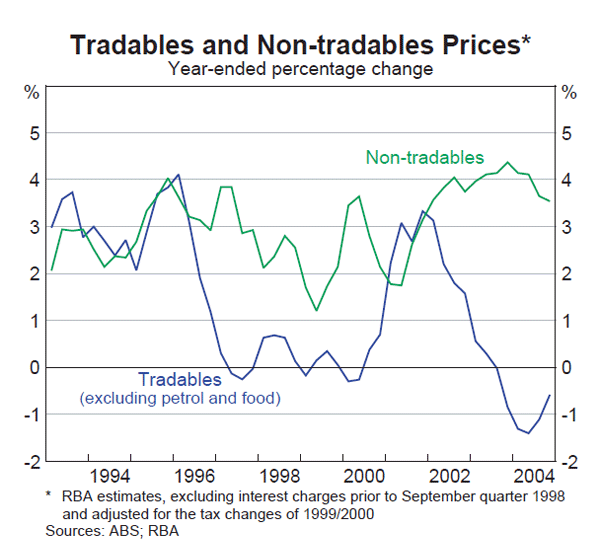
Producer prices
Producer price data for the December quarter confirm that upstream price pressures were building in the second half of 2004, with surveys and liaison continuing to highlight raw material costs as a key source of these pressures. Price indices at all stages of production increased more rapidly in the second half of 2004 than in the first half (Table 16). The prices of outputs from the final stage of production increased by 4.3 per cent over the year to the December quarter (Graph 56). Higher world oil prices had a direct effect at all stages of production through price rises for items such as oil, gas and refined petroleum products, while second-round effects were evident in price rises for a number of items, most notably basic chemical manufactures and road freight. In addition to the direct effects of high oil prices, broader upstream inflationary pressures were apparent, including further increases in building construction prices. The dampening effect of falling imported goods prices at the final stage of production continued to ease over the year to December, suggesting that the disinflationary impetus from the appreciation of the exchange rate in 2002 and 2003 has moderated substantially.
| First half 2004 (annualised) | Second half 2004 (annualised) | Year to December quarter 2004 |
|
|---|---|---|---|
| Preliminary | 3.7 | 8.9 | 6.3 |
| – Domestically produced | 3.5 | 8.2 | 5.8 |
| – Imported | 7.2 | 12.1 | 9.6 |
| – Excluding oil | 2.5 | 6.0 | 4.2 |
| Intermediate | 2.5 | 7.0 | 4.7 |
| – Domestically produced | 2.6 | 7.0 | 4.8 |
| – Imported | 2.0 | 6.4 | 4.2 |
| – Excluding oil | 1.6 | 5.1 | 3.3 |
| Final(a) | 3.4 | 5.2 | 4.3 |
| – Domestically produced | 4.6 | 6.4 | 5.5 |
| – Imported | −3.0 | −1.4 | −2.2 |
| – Excluding oil | 2.7 | 4.7 | 3.7 |
|
(a) Excluding exports Source: ABS |
|||
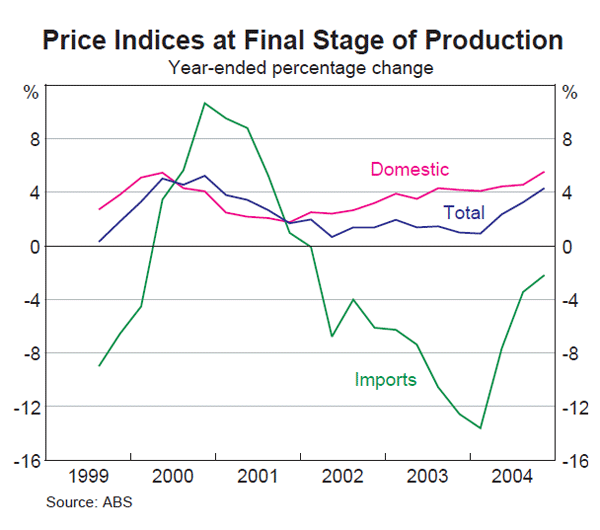
The price of construction output continued to increase at a rapid pace in the December quarter, to be more than 8 per cent higher in year-ended terms. Higher labour costs, due to skill shortages, and higher material costs, particularly for steel products, contributed to this price movement. In the manufacturing industry, the sharp increases seen in the September quarter in the prices of materials used and articles produced were followed by further price rises in December.
Labour costs
Although most indicators of wage pressure remained firm in the September quarter, there was only limited evidence to suggest that these pressures were gaining economy-wide momentum. The Wage Price Index (WPI) increased by 0.9 per cent in the September quarter (Graph 57). In year-ended terms, growth in the WPI was 3.5 per cent and has changed little since March 2003. The average annualised wage increase for enterprise bargaining agreements registered in the September quarter, reported by the Department of Employment and Workplace Relations (DEWR), was similar to that seen over the past year at 4.1 per cent. The average annualised wage increase for all current agreements remained at 3.9 per cent. Official data on labour costs based on wage-bill measures, such as average compensation of employees and average weekly ordinary time earnings, also gave little indication of emerging widespread wage pressure in the September quarter.

The WPI measure of public-sector wage growth, at 3.9 per cent in year-ended terms, remained higher than private-sector growth, which stood at 3.4 per cent. Wage growth for the construction sector was 4.5 per cent over the year to the September quarter, which is the largest increase in the relatively short history of this series and is consistent with the recent strength in activity of this industry. Other significant year-ended wage increases were recorded for a number of industries with substantial public-sector representation, such as education. The average annualised wage increase across new enterprise agreements, as reported by DEWR, was also slightly larger for the public sector than for the private sector.
Business survey data for the December quarter suggest that it is becoming increasingly difficult to find suitable skilled labour (Graph 58). This is consistent with the recent strength in the labour market and with liaison, where reports of skill shortages remain widespread. In particular, liaison reports suggest that the strength in activity in the resources and non-residential construction industries has intensified shortages of skilled workers, leading to solid increases in wages and sub-contractor rates in those industries. Sharp increases in wages have also been reported in localised parts of the business services sector where skill shortages are particularly acute. In contrast, more broadly based business survey data for the December quarter suggest that wage pressures have not increased significantly. The NAB Quarterly Survey reported that year-ended growth in labour costs was broadly unchanged in December, and a similar rate of growth is expected in the March quarter.
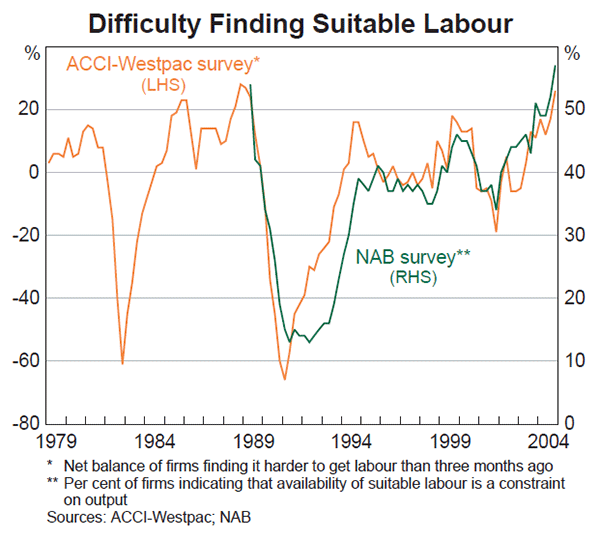
One possible reconciliation between the wage pressures reported in liaison and the relatively more contained official data would be that the former capture increases in sub-contractor rates for self-employed workers that are not covered by standard wage measures. Many firms have reported rapid growth in non-wage bonus payments and a number have also reported increases in training costs.
Inflation expectations
Most indicators suggest that inflation is expected to increase over the next two years. The Bank's survey of market economists showed that the median forecast for CPI inflation for the year to June 2005 was unchanged following the release of the December quarter CPI (Table 17). The median expectation for CPI inflation over the year to June 2006 increased slightly. Union officials' median expectations also continue to point to a slight pick-up in inflation, with inflation expected to increase to 3 per cent by the end of 2005 and stabilise around this level.
| Year to June 2005 | Year to June 2006 | |||||
|---|---|---|---|---|---|---|
| August 2004 | November 2004 | February 2005 | November 2004 | February 2005 | ||
| Market economists(a) | 2.4 | 2.4 | 2.4 | 2.5 | 2.6 | |
| Union officials(b) | 3.0 | 3.0 | 2.8 | 3.0 | 3.0 | |
| (a) RBA survey (b) ACIRRT survey |
||||||
Business surveys report that current inflationary pressures have firmed over the past quarter, and that expectations of future price growth are also being adjusted upwards. Both the ACCI-Westpac survey of manufacturing and the Dun & Bradstreet survey reported a rise in the net balance of firms increasing selling prices in the December quarter and expecting to increase prices in the coming months. The NAB survey reported that economy-wide product price inflation increased in the December quarter, while retail product price inflation was broadly steady. Both economy-wide and retail price inflation are expected to pick up in the March quarter. In contrast, medium-term inflation expectations implied by financial market prices, which are calculated as the difference between nominal and indexed bond yields, have been broadly stable at around 2.6 per cent over the past nine months. The median inflation expectations of consumers, as reported by the Melbourne Institute survey, have remained within their range of the past five years.
Inflation outlook
CPI inflation was 2.6 per cent over the year to the December quarter but as noted above, the Bank's assessment is that underlying inflation was around 2¼ per cent, similar to the previous few quarters. This will probably be the low point for underlying inflation in the current cycle, and is a higher trough than expected a year ago. While ongoing strength in domestic inflation over the past couple of years has been offset by the disinflationary effect of the large appreciation of the exchange rate in 2002 and 2003, this effect has probably been less than would have been expected based on previous experience. Looking ahead, further impacts from the exchange rate appreciation are likely to be limited: in fact, the prices of tradables (excluding food and petrol) were flat in the December quarter and their decline in year-ended terms moderated in the second half of 2004. Accordingly, underlying inflation is expected to pick up gradually to around 2½ per cent by the end of 2005 and to around 3 per cent by the end of 2006. This profile is broadly in line with that presented in the November 2004 Statement, although the forecast provided at that time only extended to mid 2006.
The nature of the risks to the forecasts has shifted since then. The November Statement identified the pick-up in world oil prices in the second half of 2004 as the major risk to the inflation outlook, and the higher level of oil prices did contribute to the upstream inflationary pressures in producer prices in the December quarter. But given the easing in oil prices since then, the risk posed by oil for the inflation profile has receded somewhat. Instead, domestic pressures now present the biggest risk to the inflation profile. Production costs have increased over the past half year, as a result of higher raw materials prices, largely reflecting a period of strong domestic and international demand. The forecasts for healthy world growth in 2005 and the current broad strength in commodity prices suggest that these demand pressures will continue. In addition, labour market conditions have tightened over recent months, as seen in the above-trend growth in employment in the December quarter, the fall in the unemployment rate and reports of labour shortages and pressure on non-wage costs. These conditions increase the likelihood of wage pressures building beyond what is factored into the inflation forecast.
Footnotes
See ‘Box B: Indicators of Labour Market Tightness’ in the Statement on Monetary Policy, November 2004. [1]
The weakness in recorded metals exports has been exaggerated by statistical factors. As production has become more concentrated among firms, the ABS has imposed confidentiality restrictions on data on exports of certain types of nickel products (from February 2003) and some steel products (from September 2000), which have subsequently been included in ‘other exports’ rather than resource exports: these changes coincided with extremely sharp falls in recorded nickel and steel exports, with these falls estimated to account for around half of the decline in recorded metals exports over recent years. The result is that growth of ‘other exports’ is artificially boosted, whereas growth rates for exports of metals and total resources are biased downwards. [2]
The commissioning of the fourth LNG train at the North West Shelf gas project in late 2004 will significantly increase exports (and appears to have done so in the December quarter 2004), but did not boost LNG exports materially in the period covered by Table 9 and Graph 37. [3]
The closures include: for copper, the Port Kembla (NSW) refinery; for zinc, the Lennard Shelf (WA) mine and Cockle Creek (NSW) smelter; for iron and steel, the suspension of the Boodarie Iron (WA) plant; and for tin, the Renison Bell (Tas) mine. [4]
Including the Mount Charlotte (WA), Fortnum (WA) and Kidston (Qld) mines. [5]
The fall-off apparent for 2005/06 partly reflects the fact that only projects under construction and committed projects have been included in the analysis; many other projects are in earlier stages of planning, indicating that the figures for the forecast period are likely to be revised upwards over time. [6]
Synthetic CDOs transfer the credit risk on a portfolio of (typically) business loans from the issuer of the securities to the investor, but do not involve a sale of the underlying claims on the businesses. [7]
Footnotes Box A
The expected future volatility of the underlying asset is one of the most important determinants of the option price. There is a higher chance that an option will provide a larger payoff when the future volatility of the underlying asset is higher, because it is more likely that the price of the underlying asset will move more in favour of the option buyer while at the same time the option buyer is not exposed to the adverse movements in the price. Therefore, option prices are higher when the expected future volatility is higher. The implied volatility is the value of the volatility that equates the market price of an option to its theoretical value. Implied volatility is higher when the option price and the expected volatility are higher. As a matter of convention, the prices of options traded in over-the-counter markets are quoted in terms of the option implied volatility rather than in monetary units. [1]
Footnotes Box B
For more detail see ‘Box A: Global Foreign Exchange Turnover’, Statement on Monetary Policy, November 2004. [1]